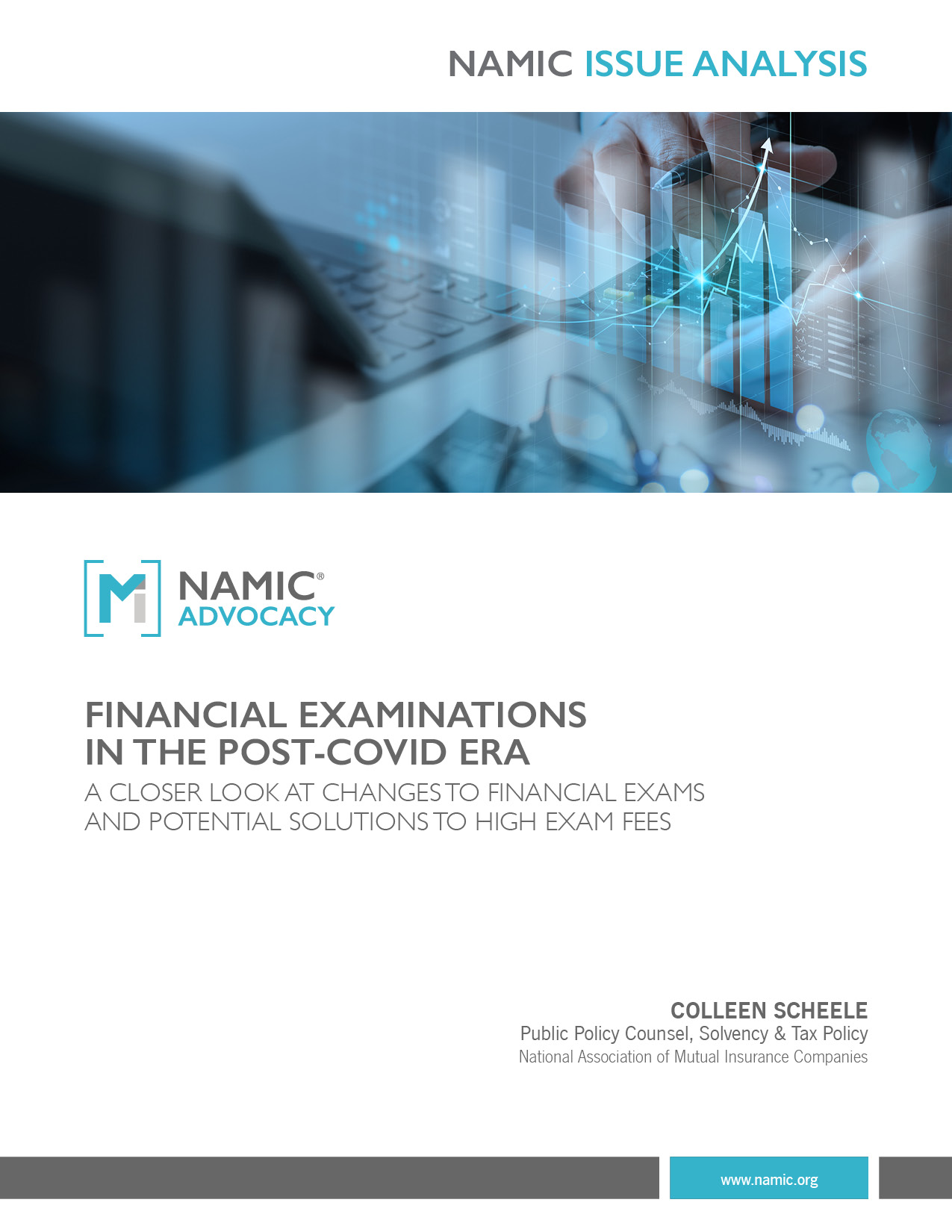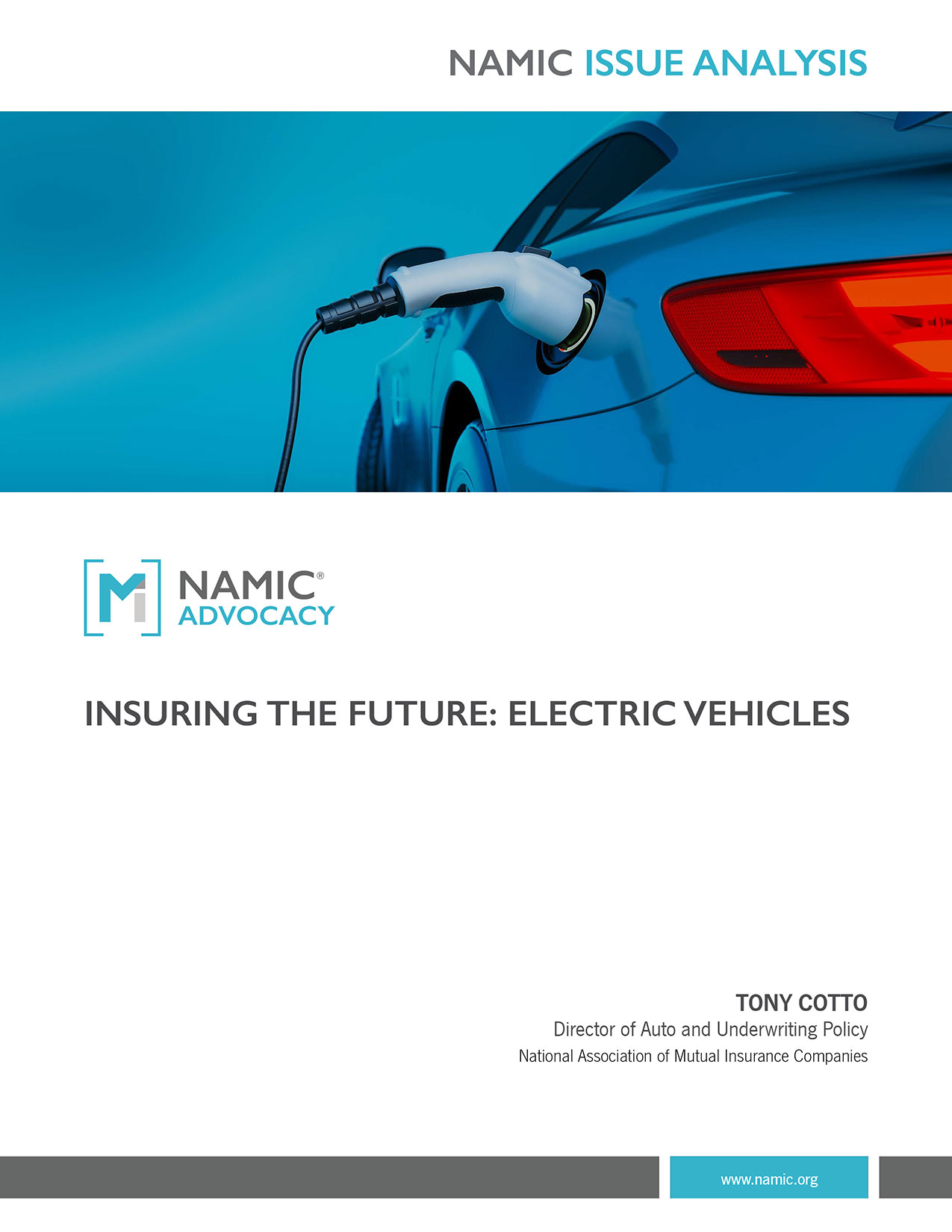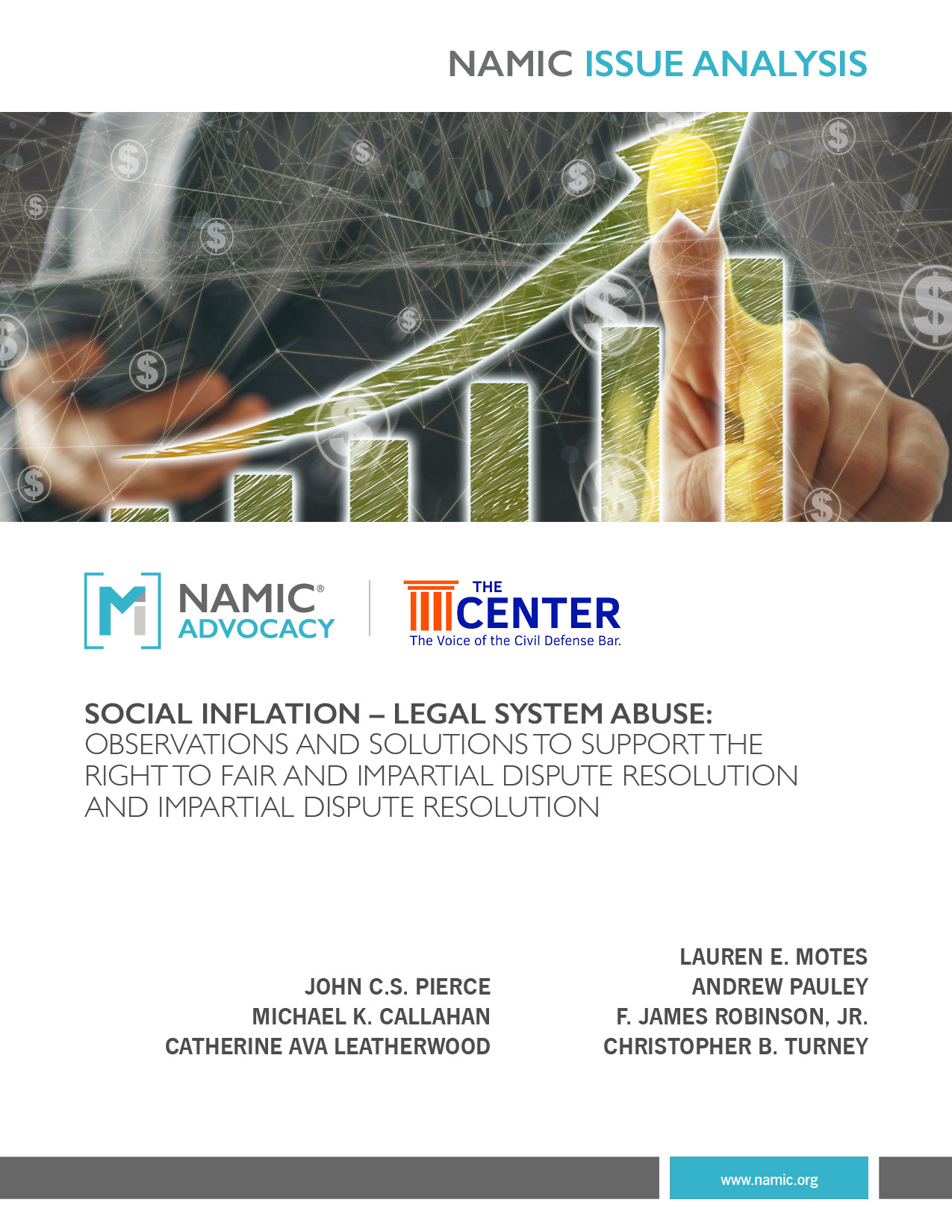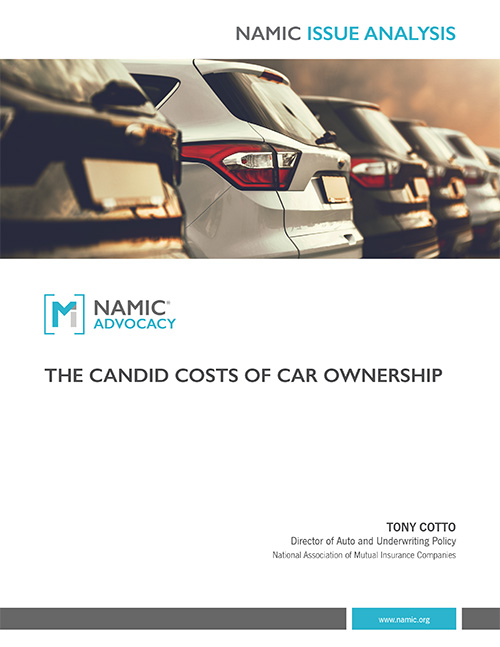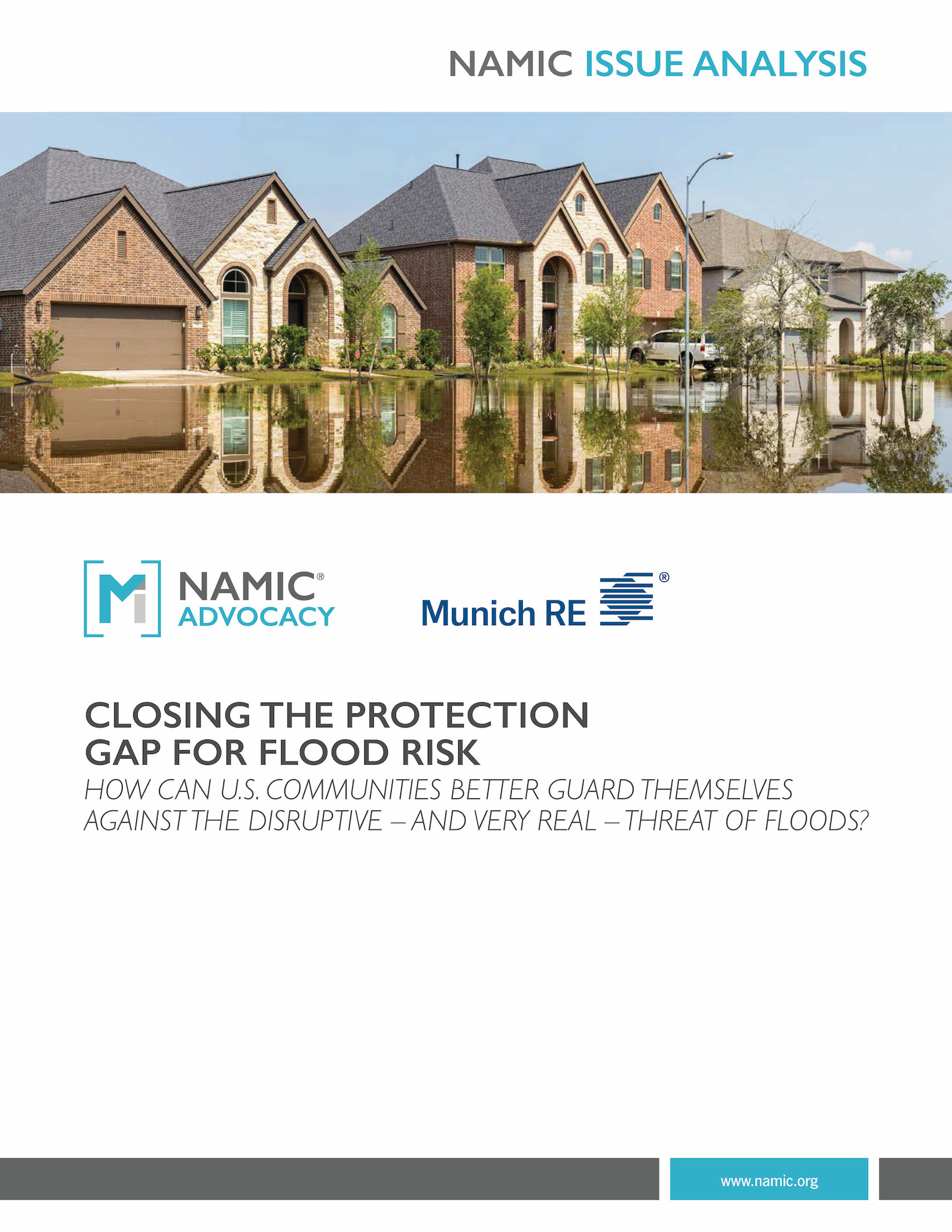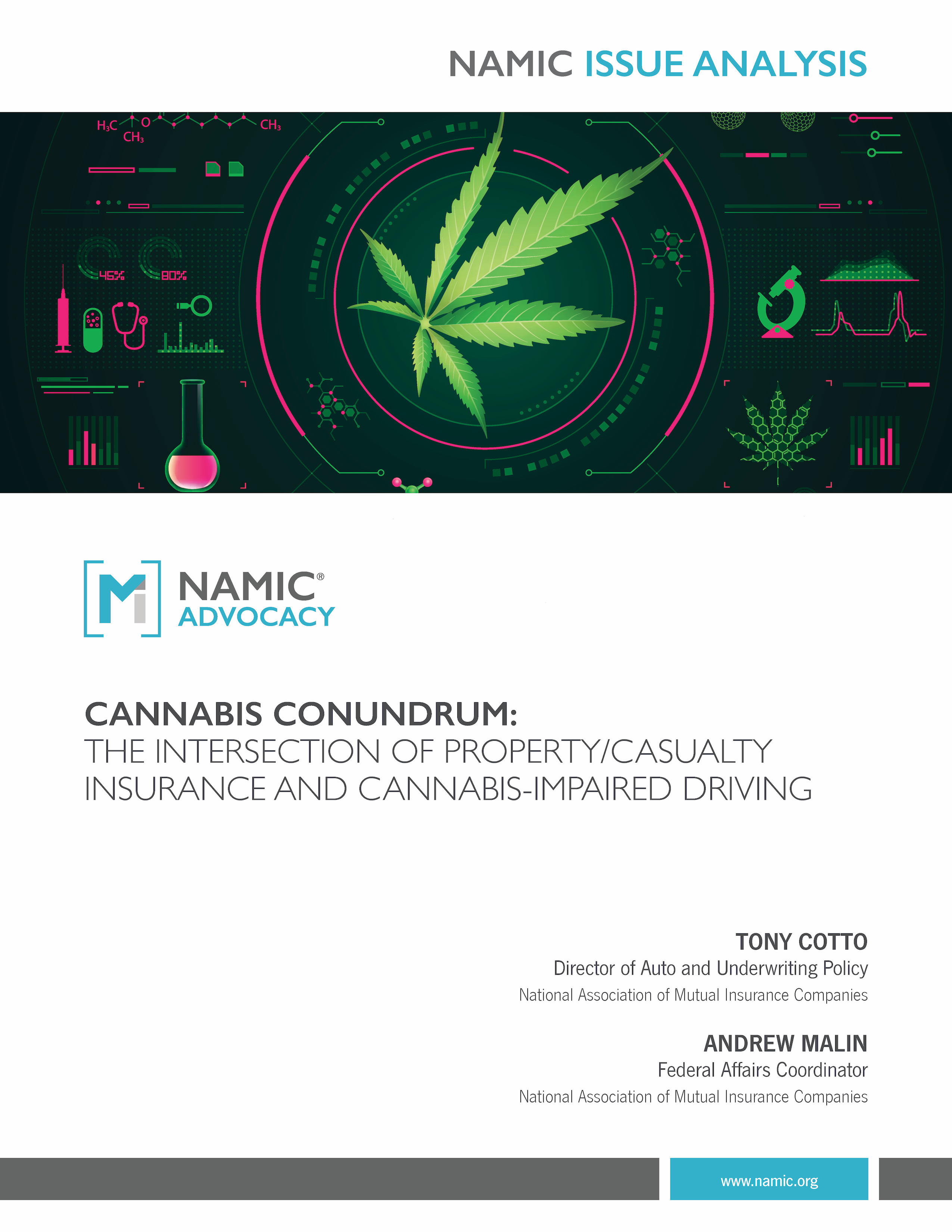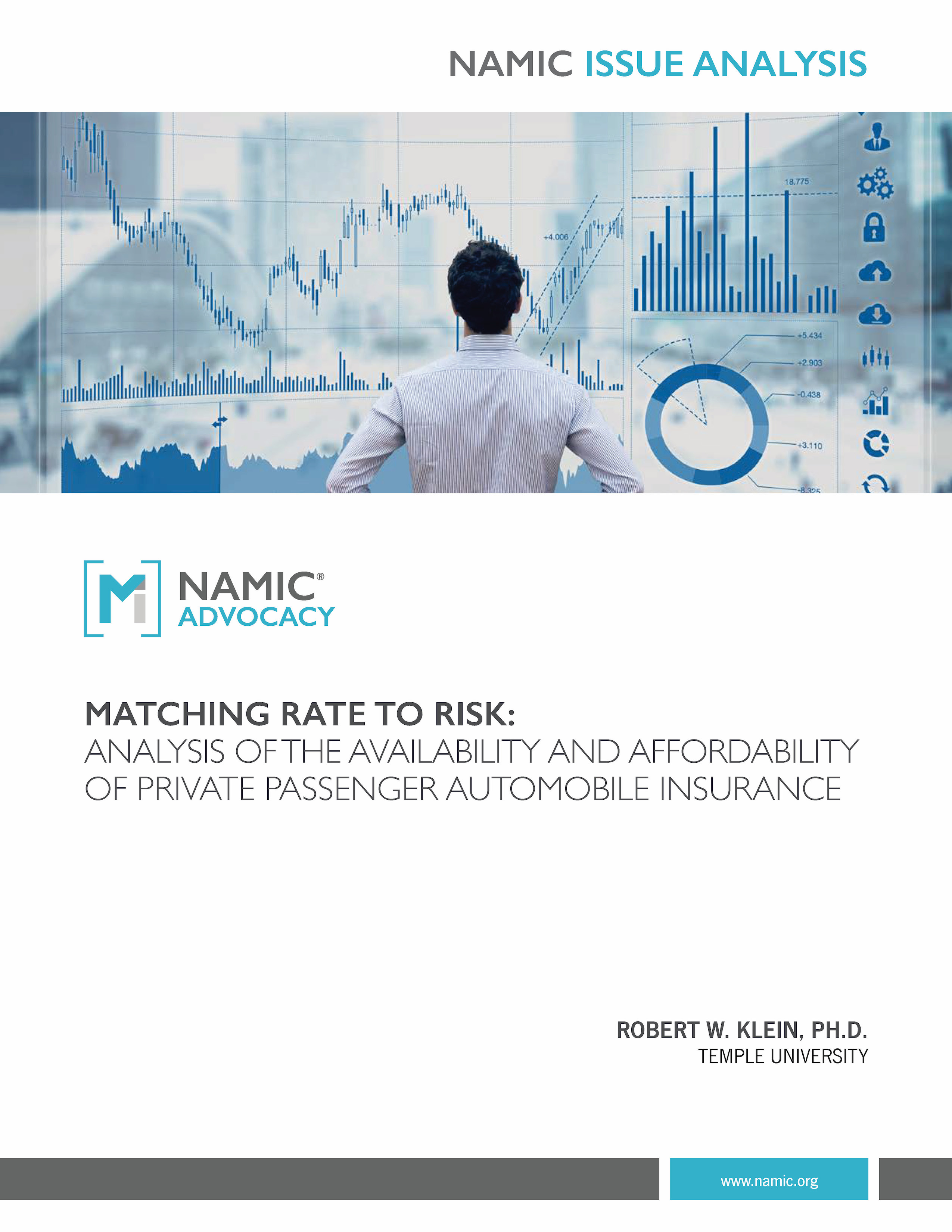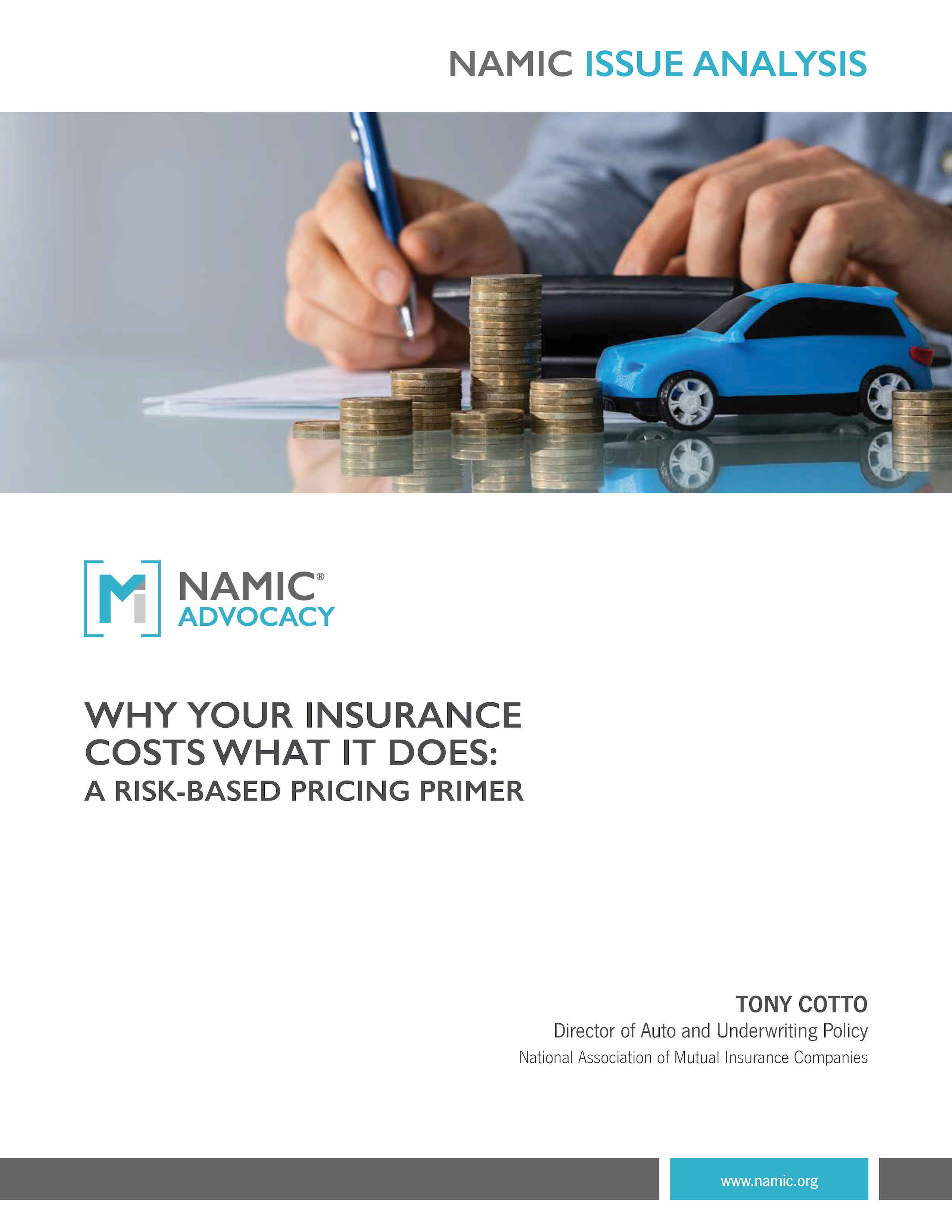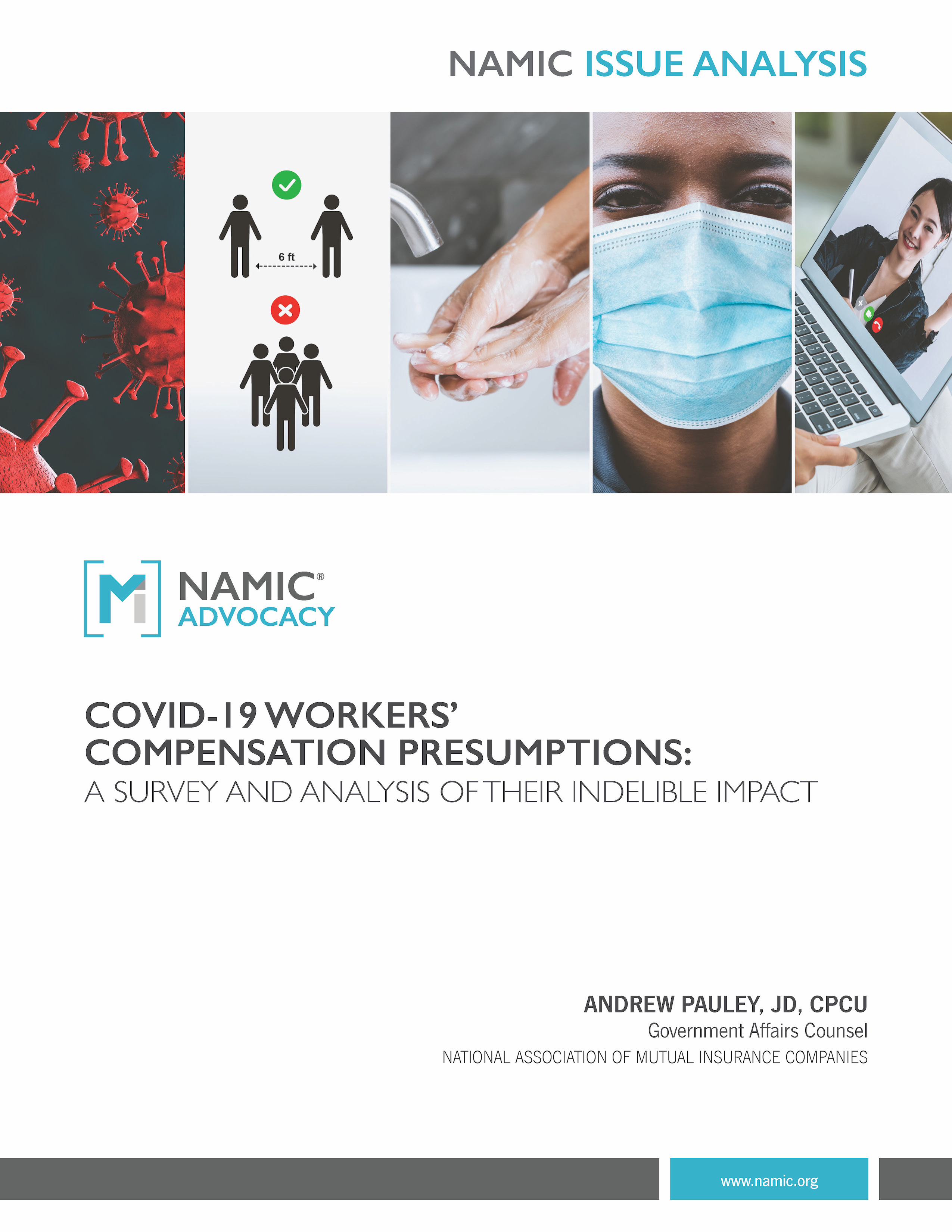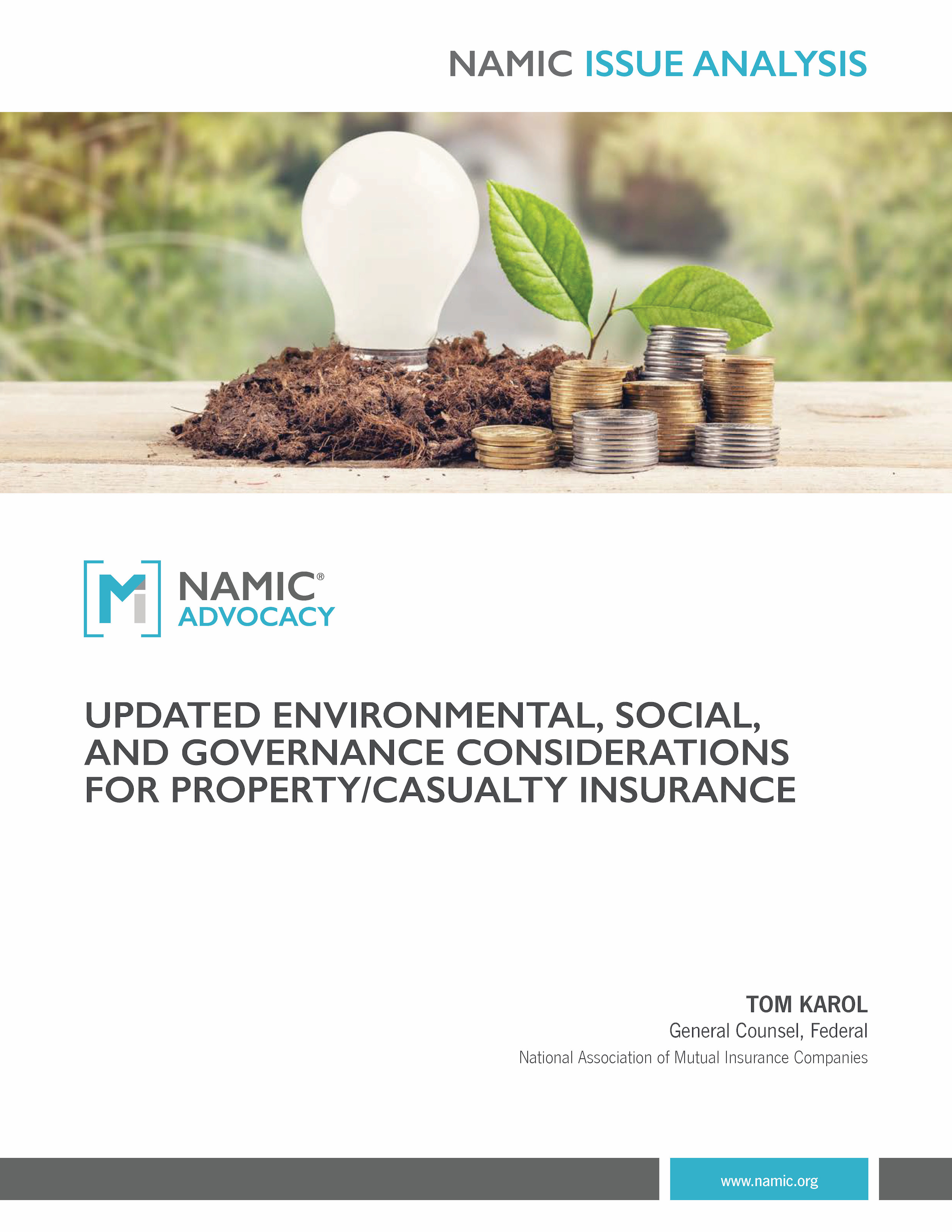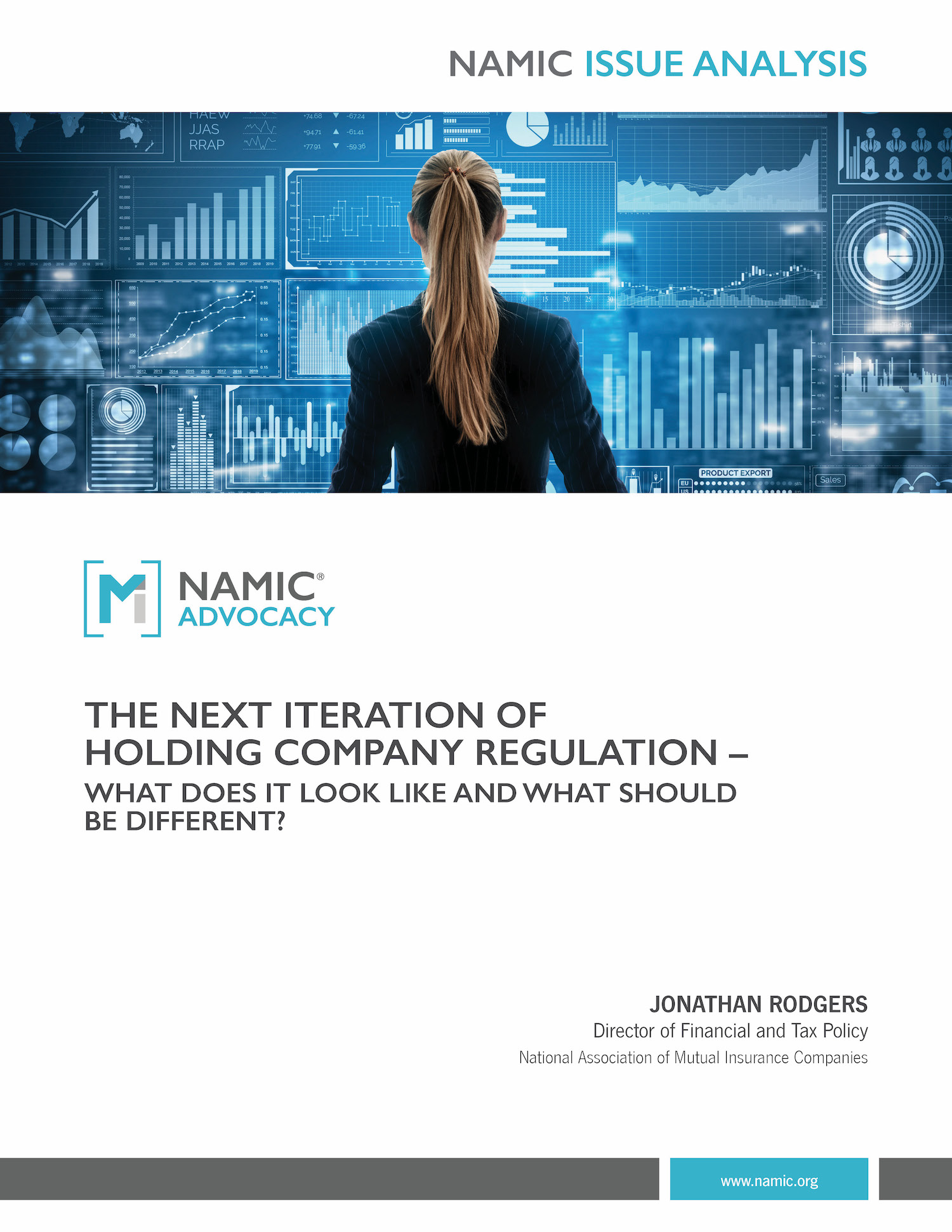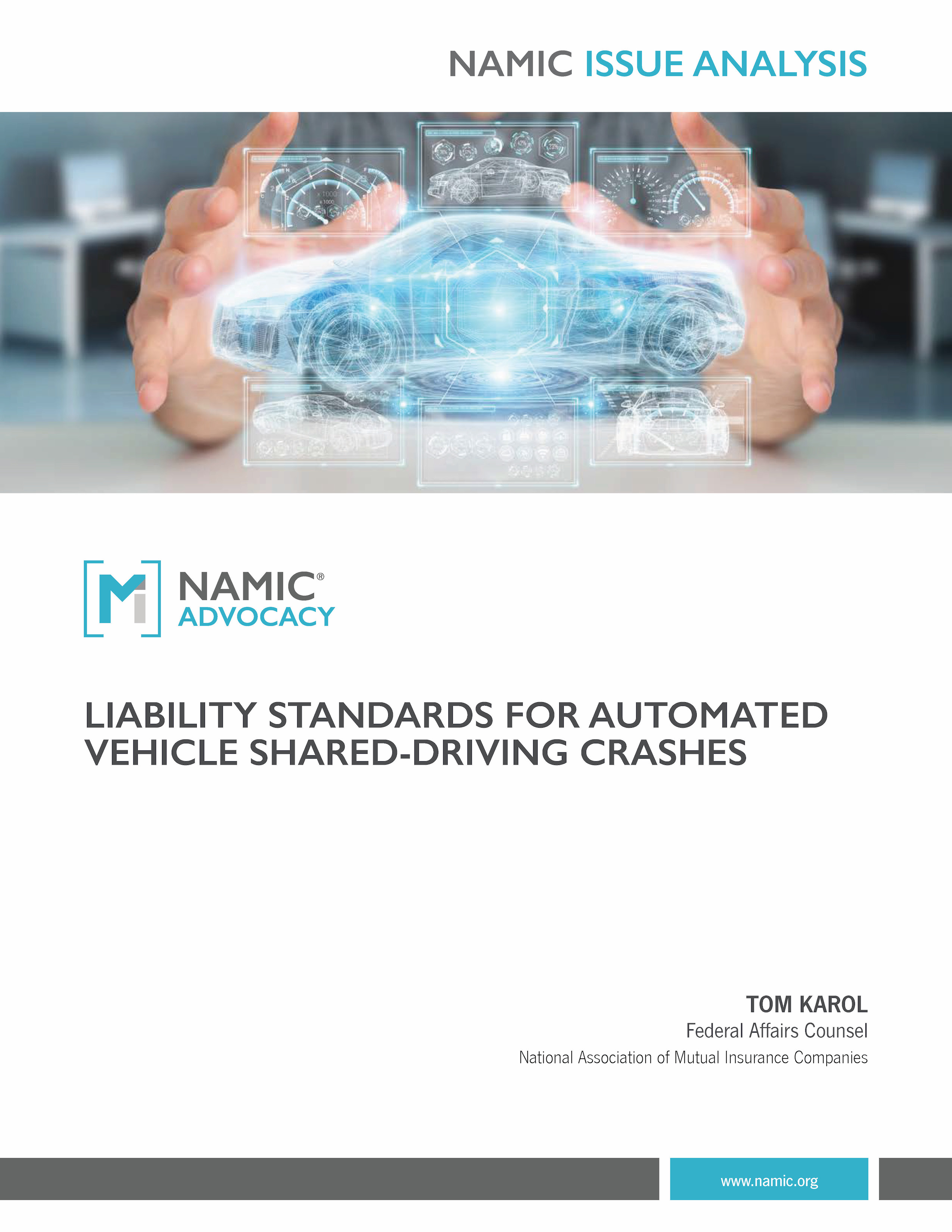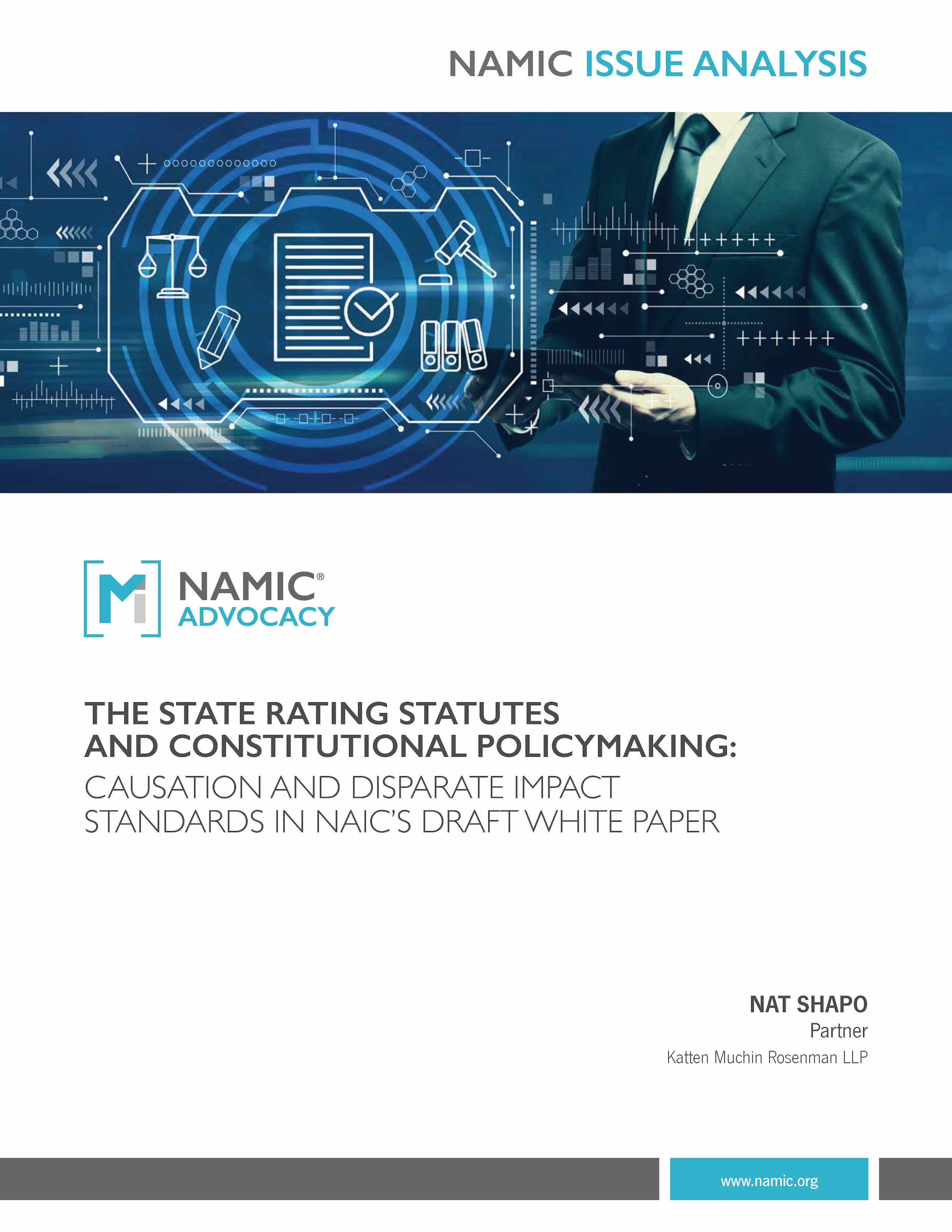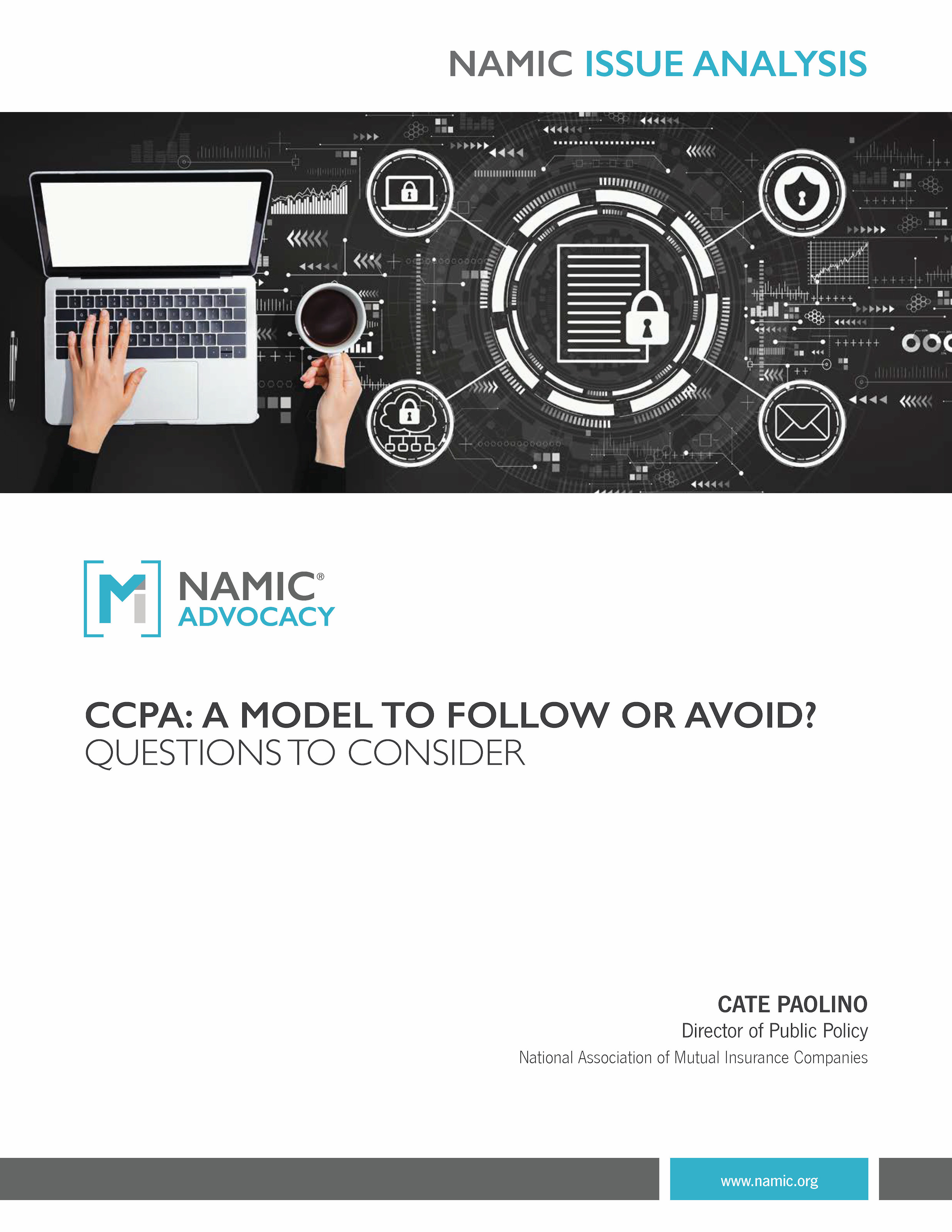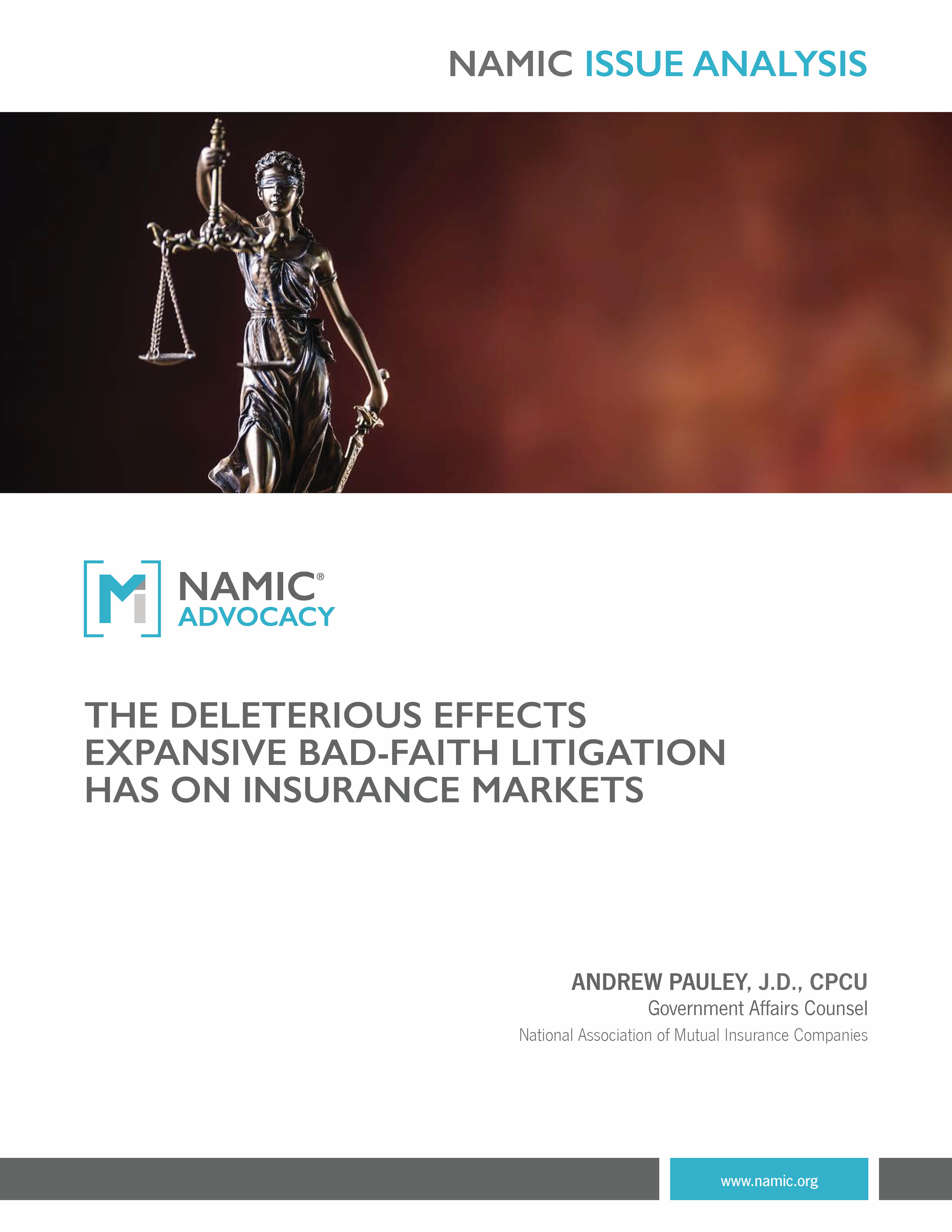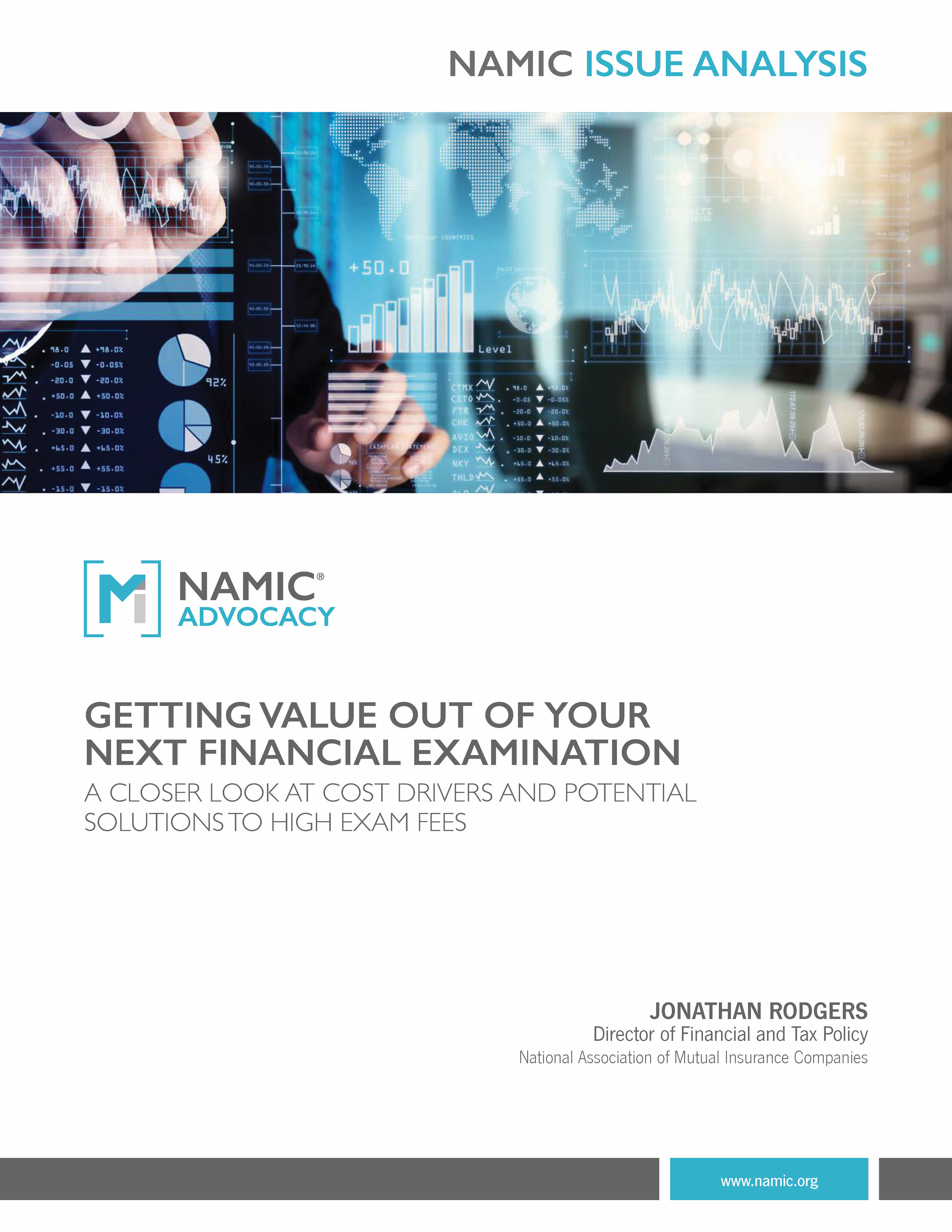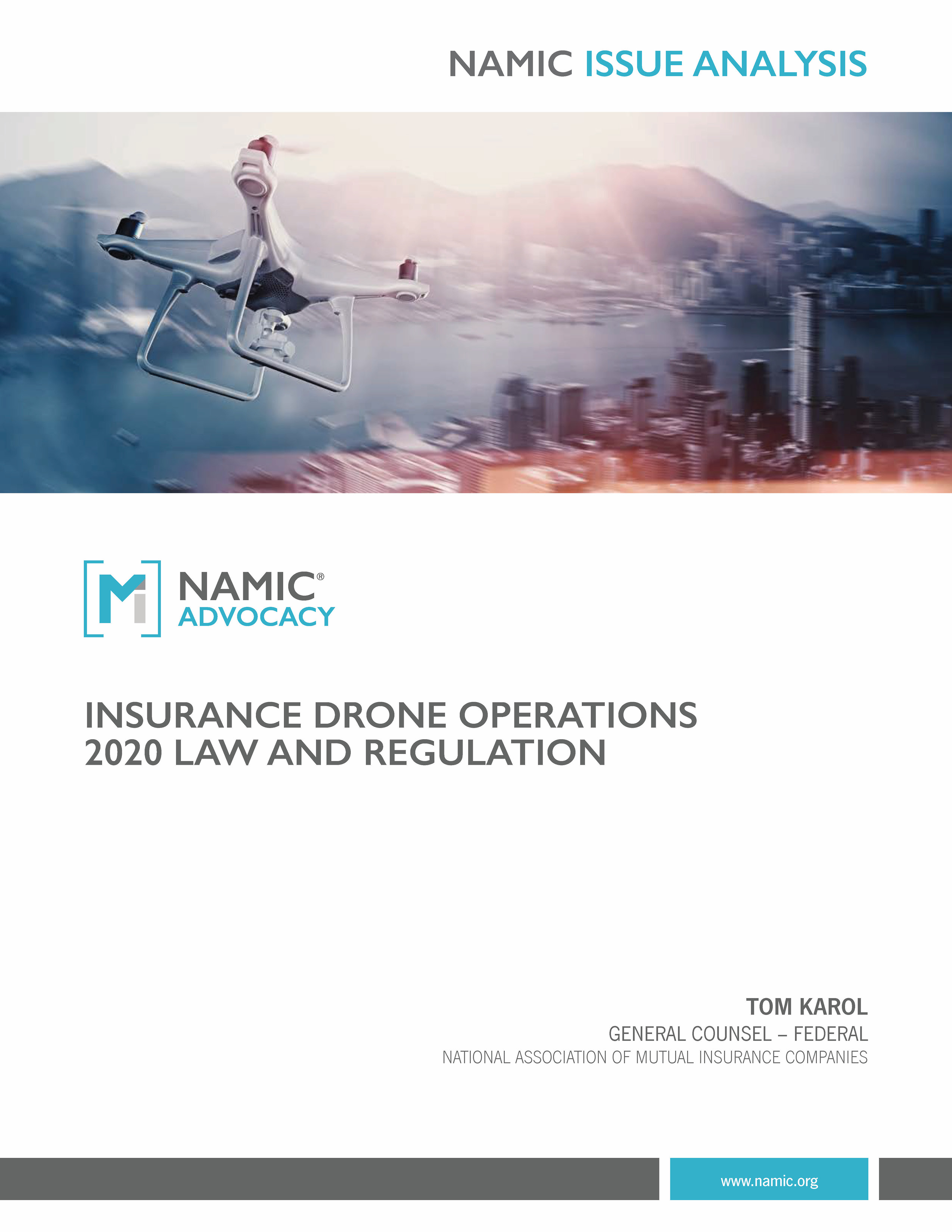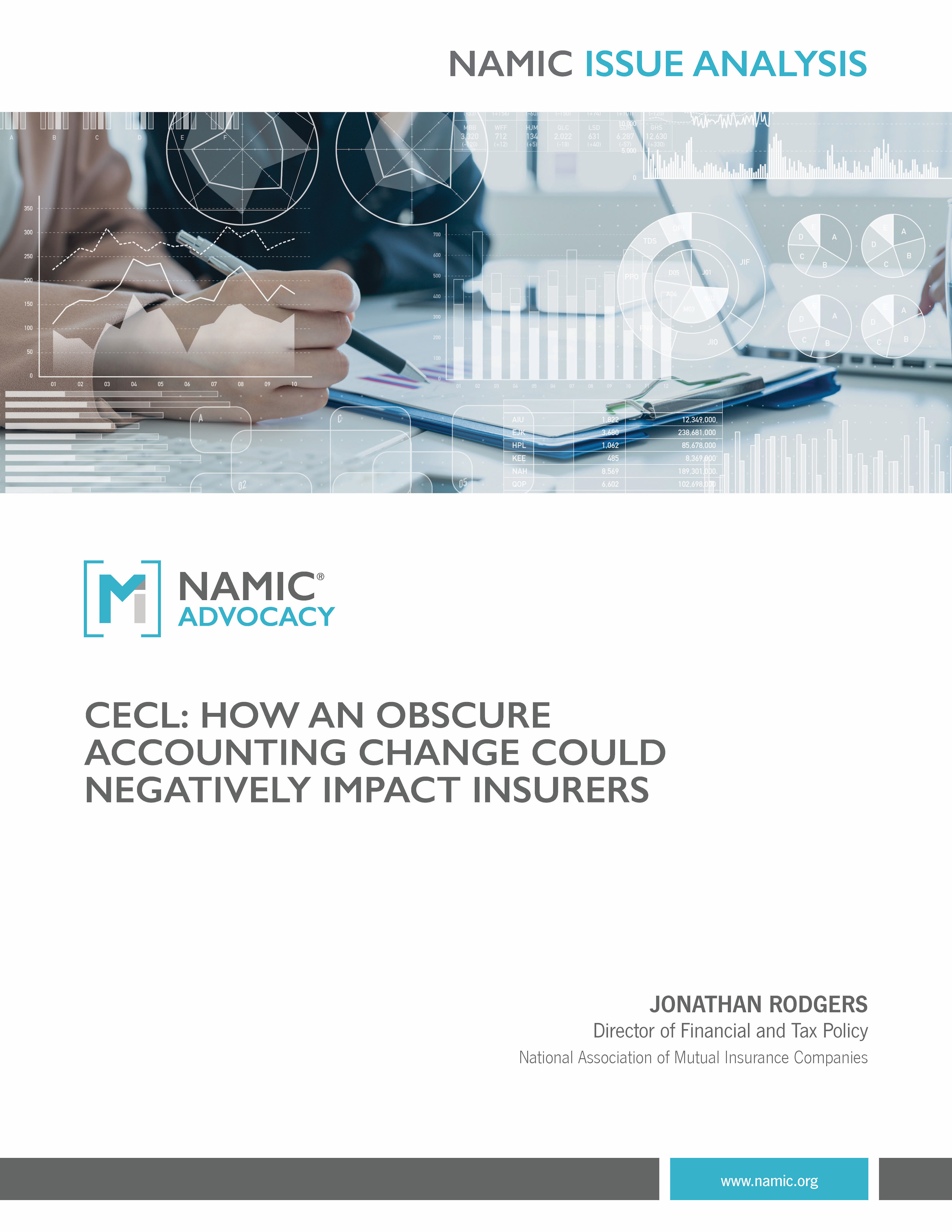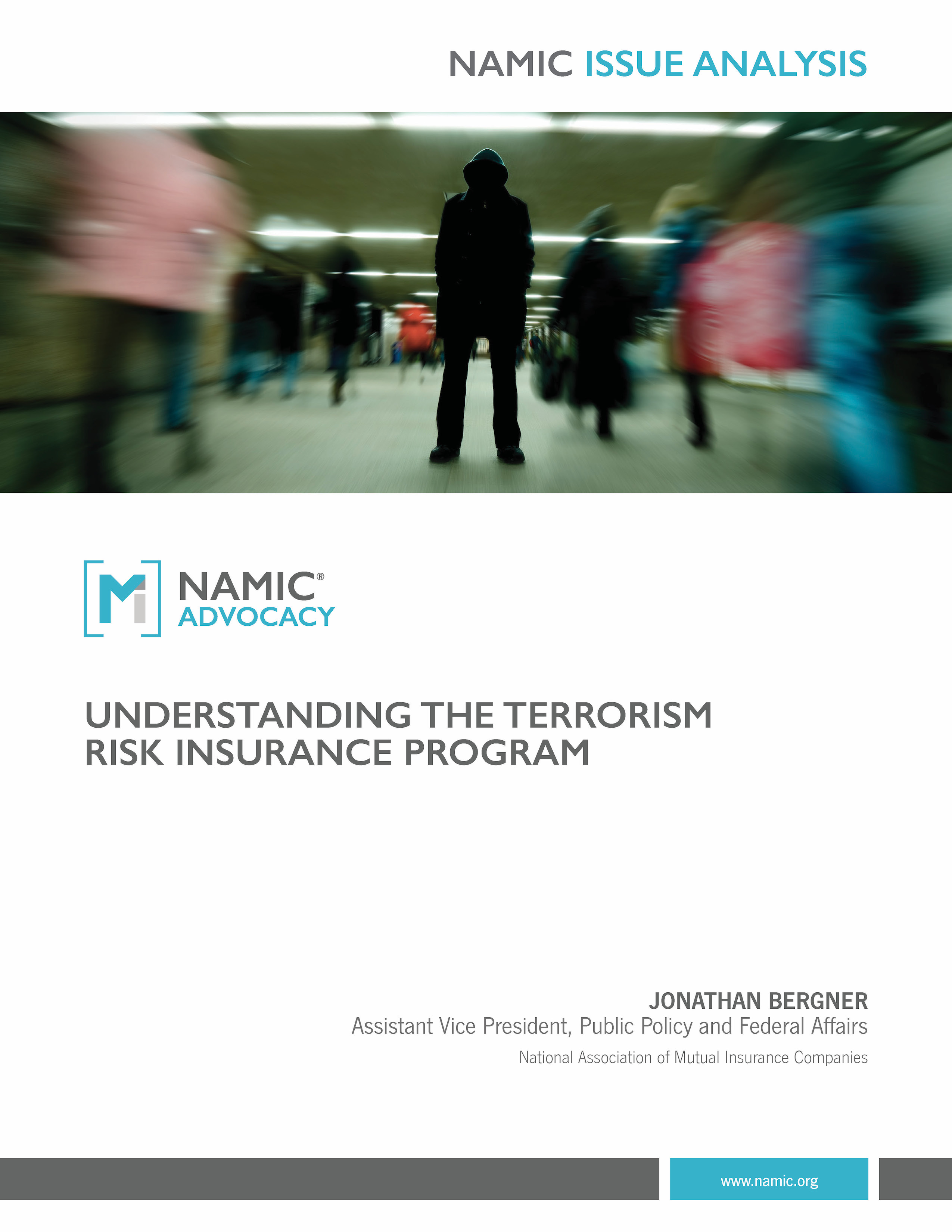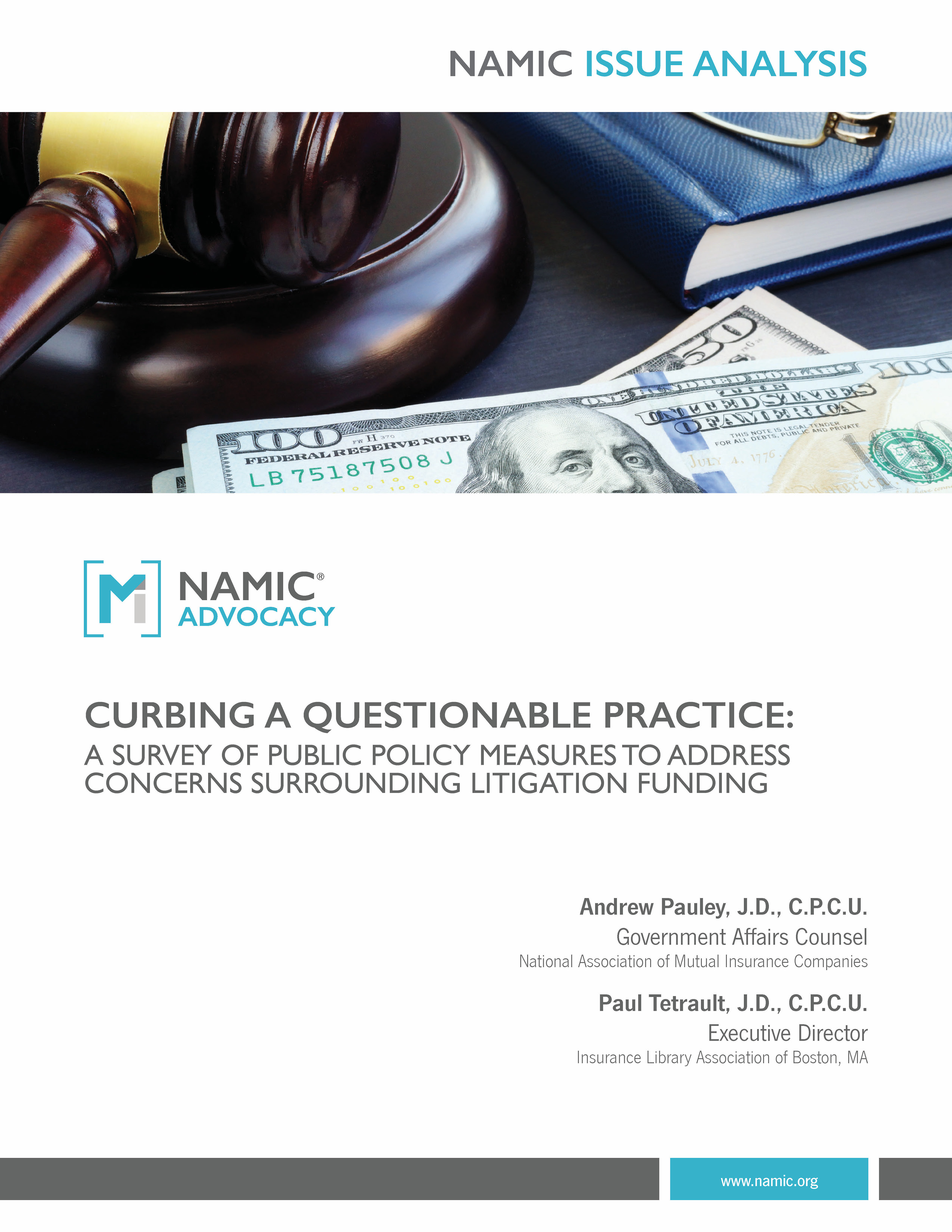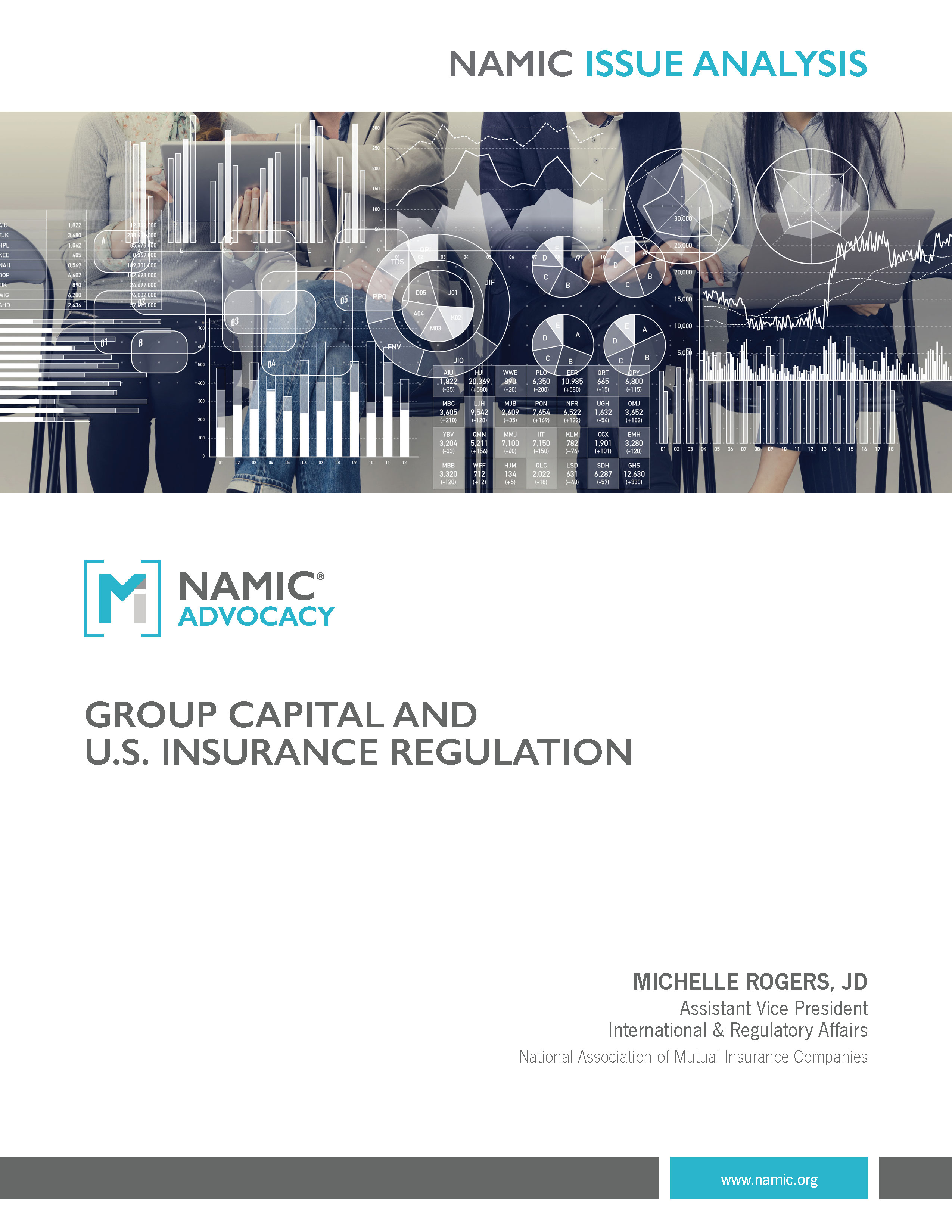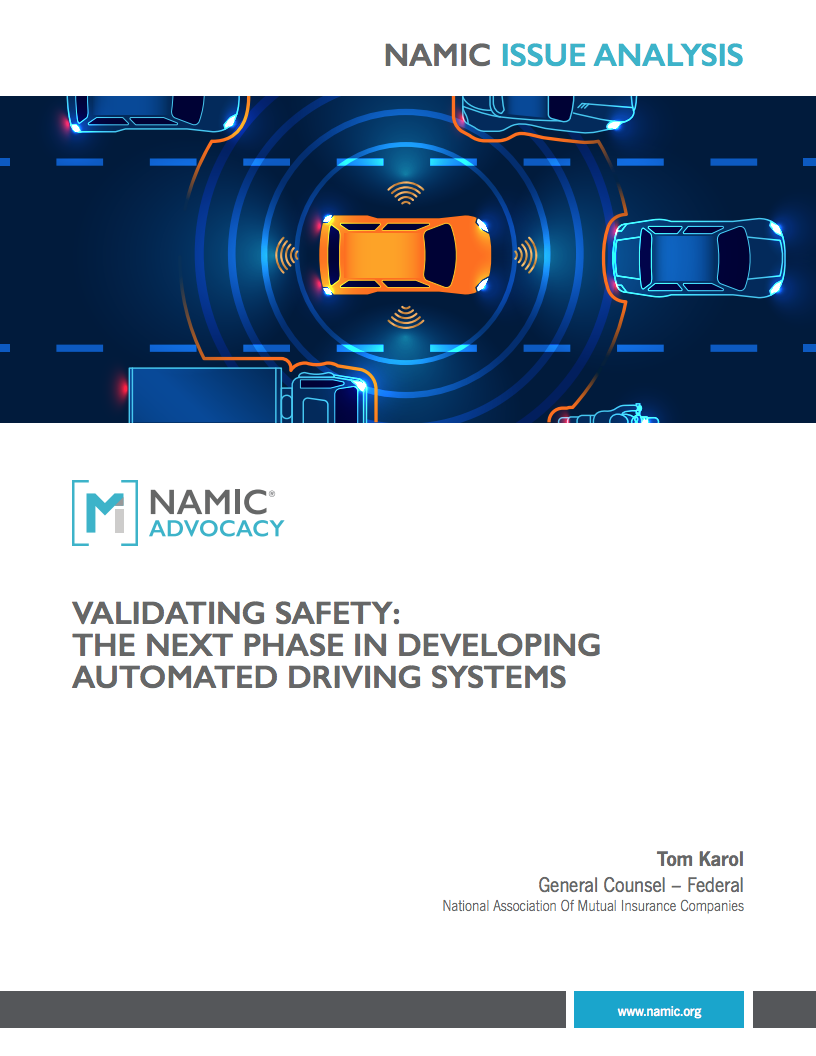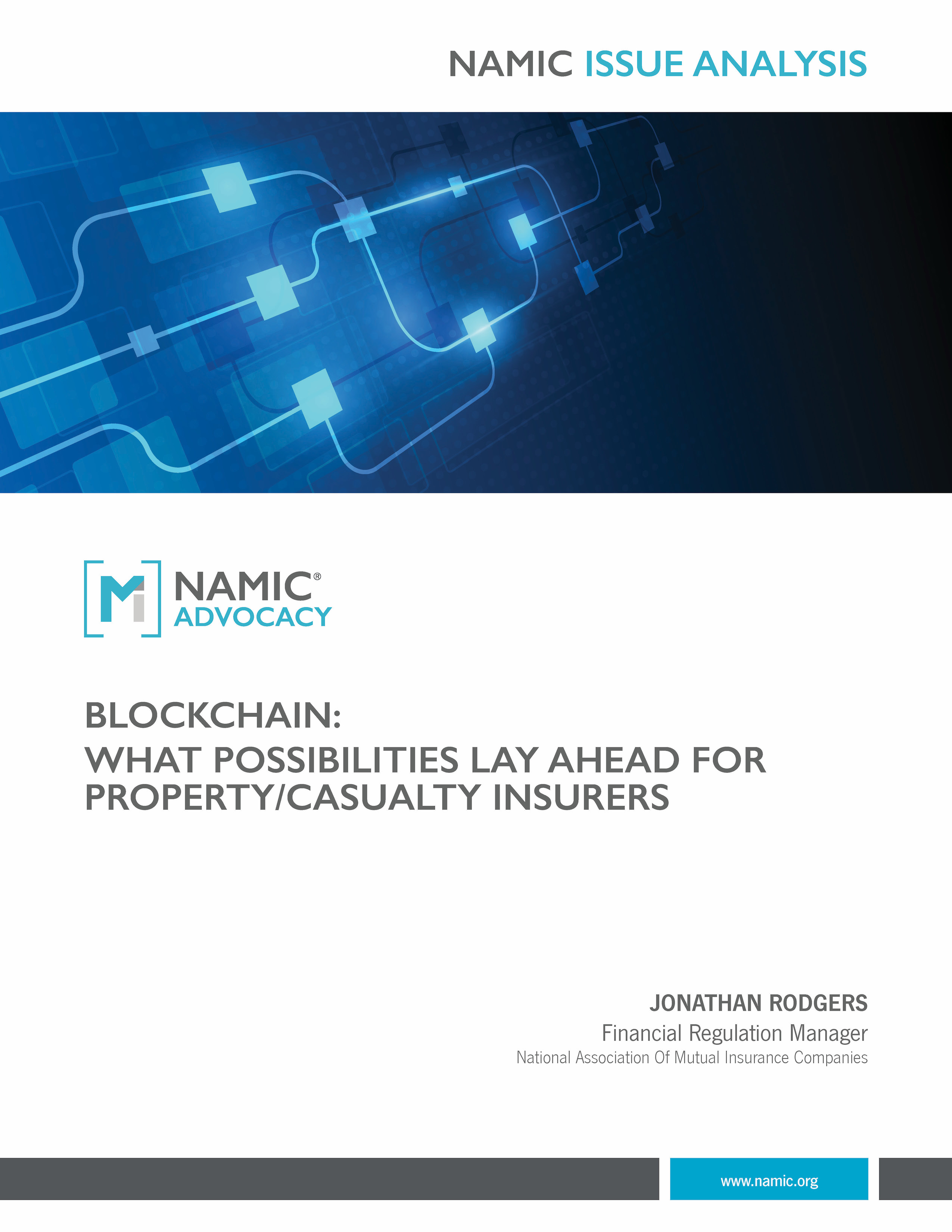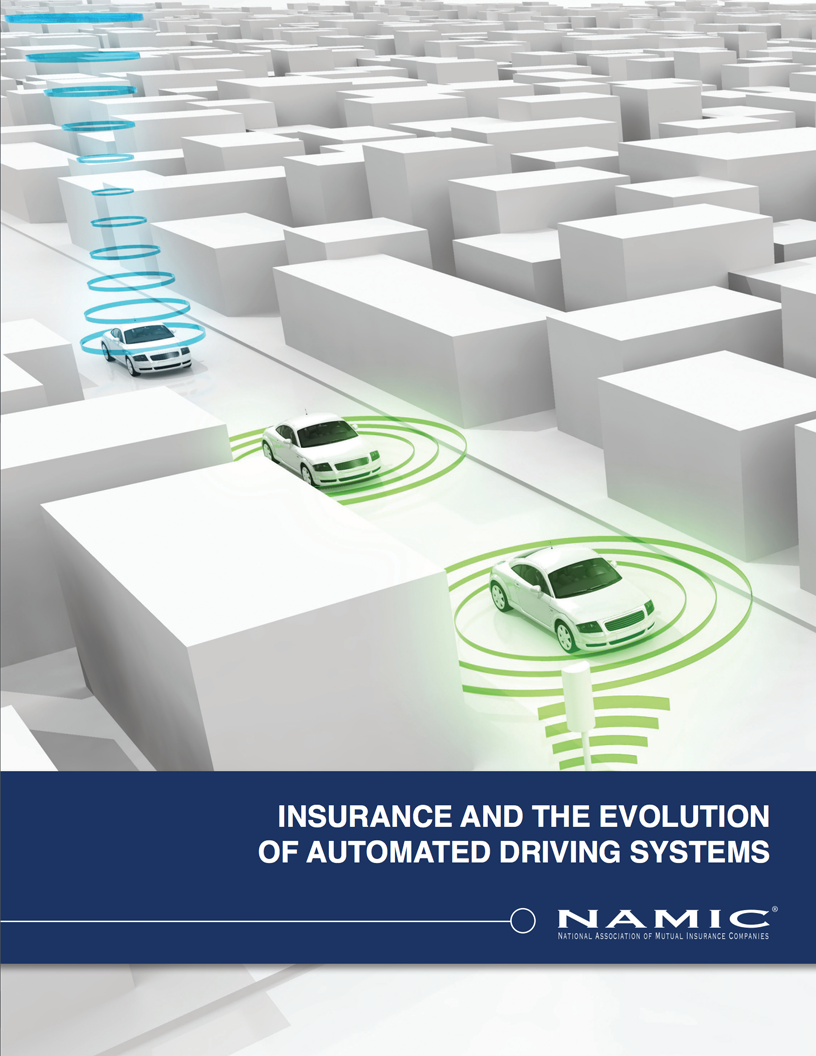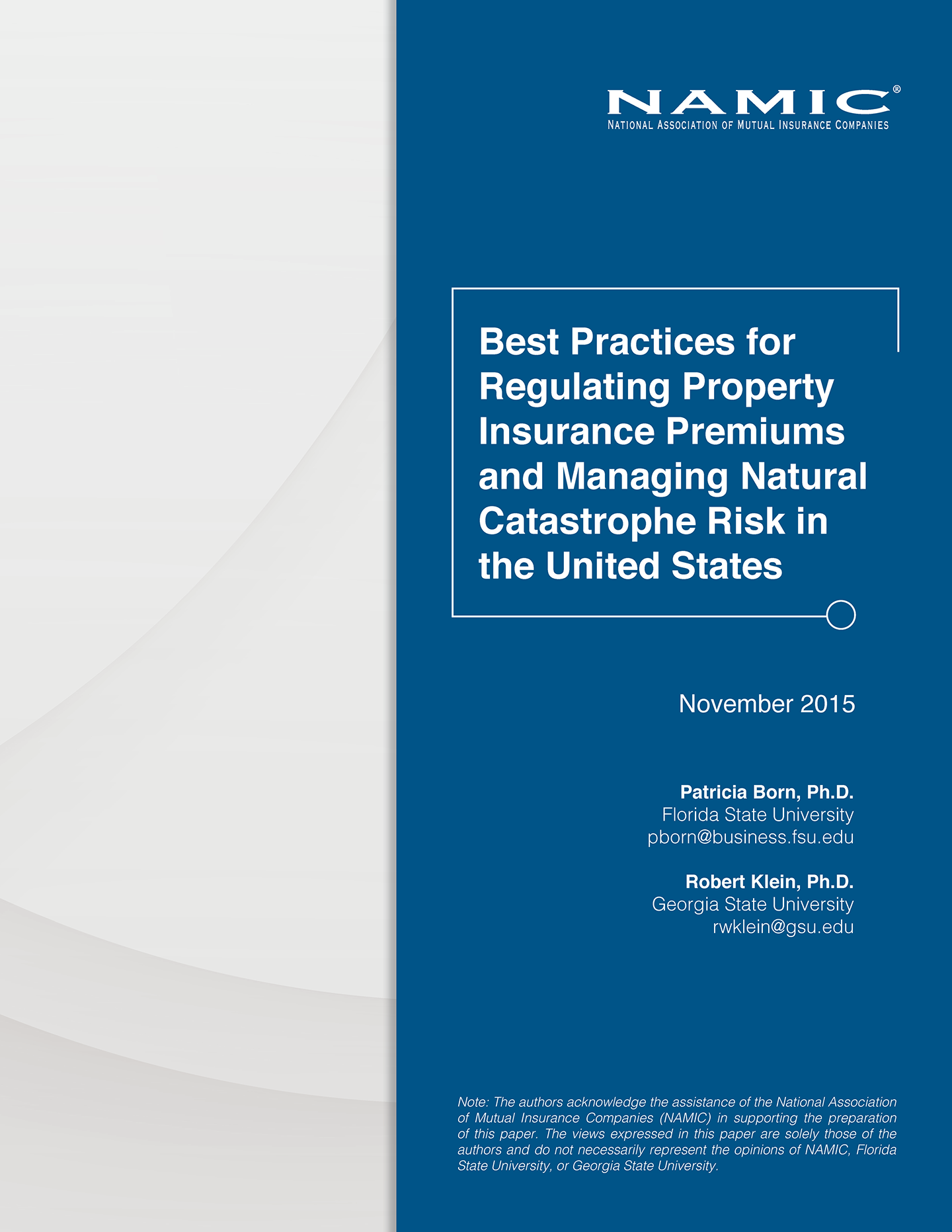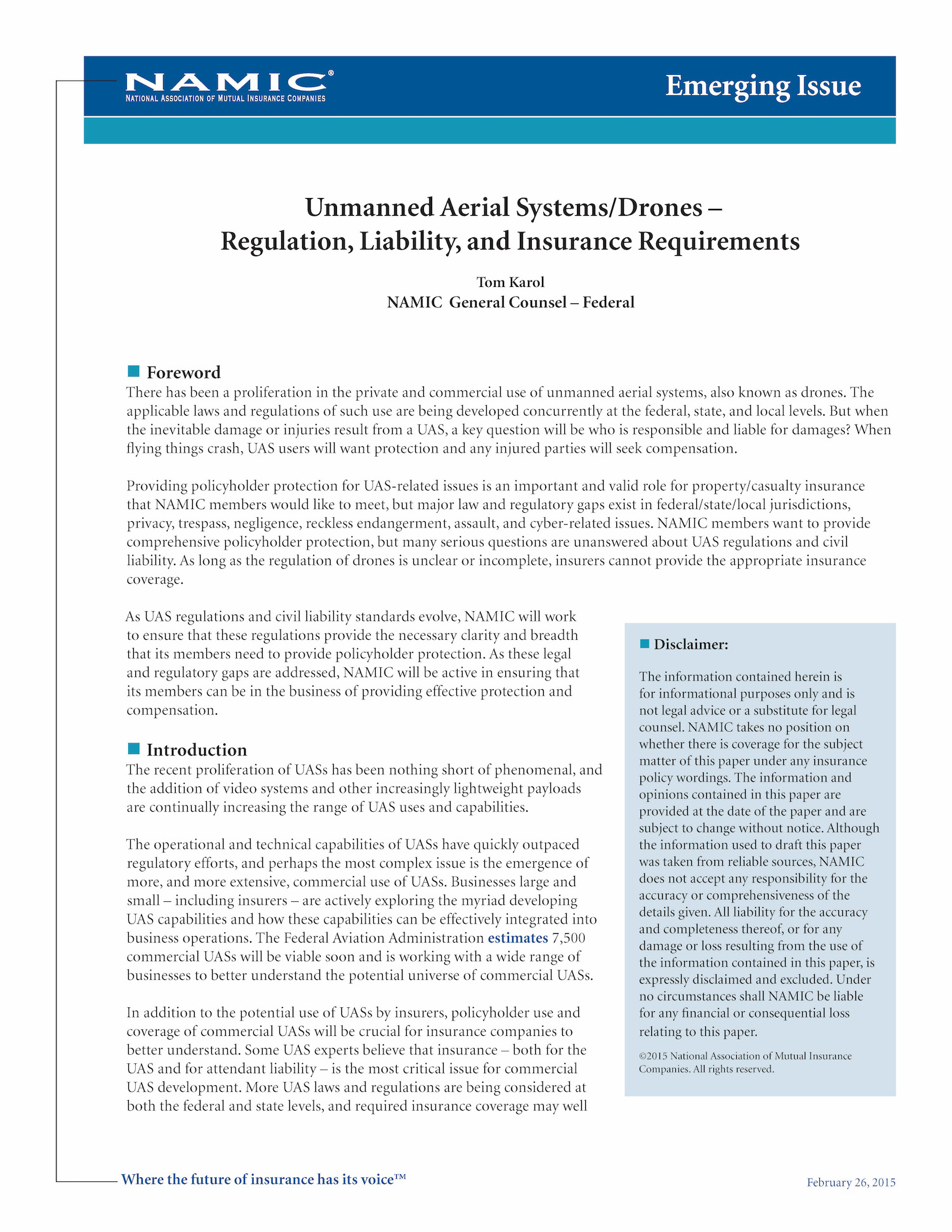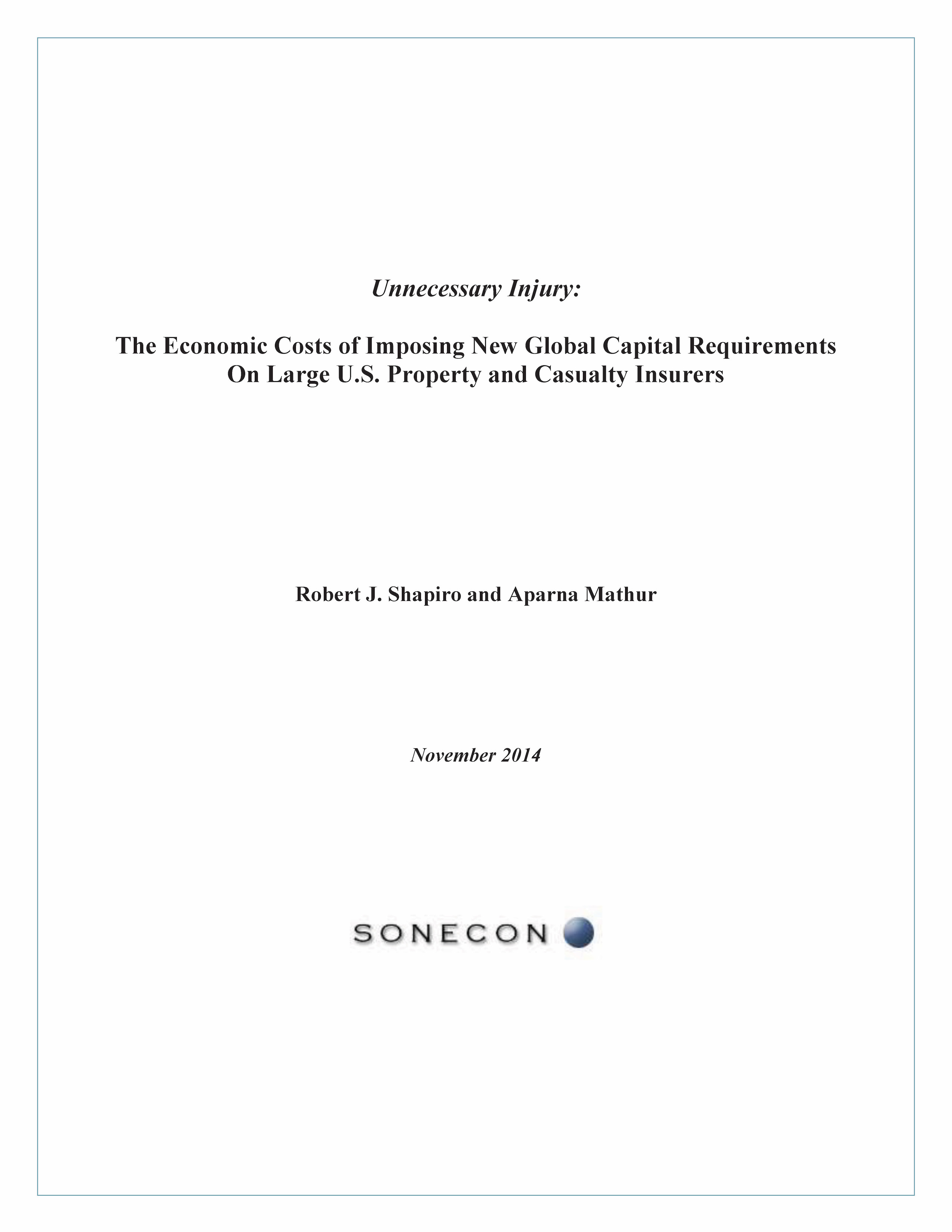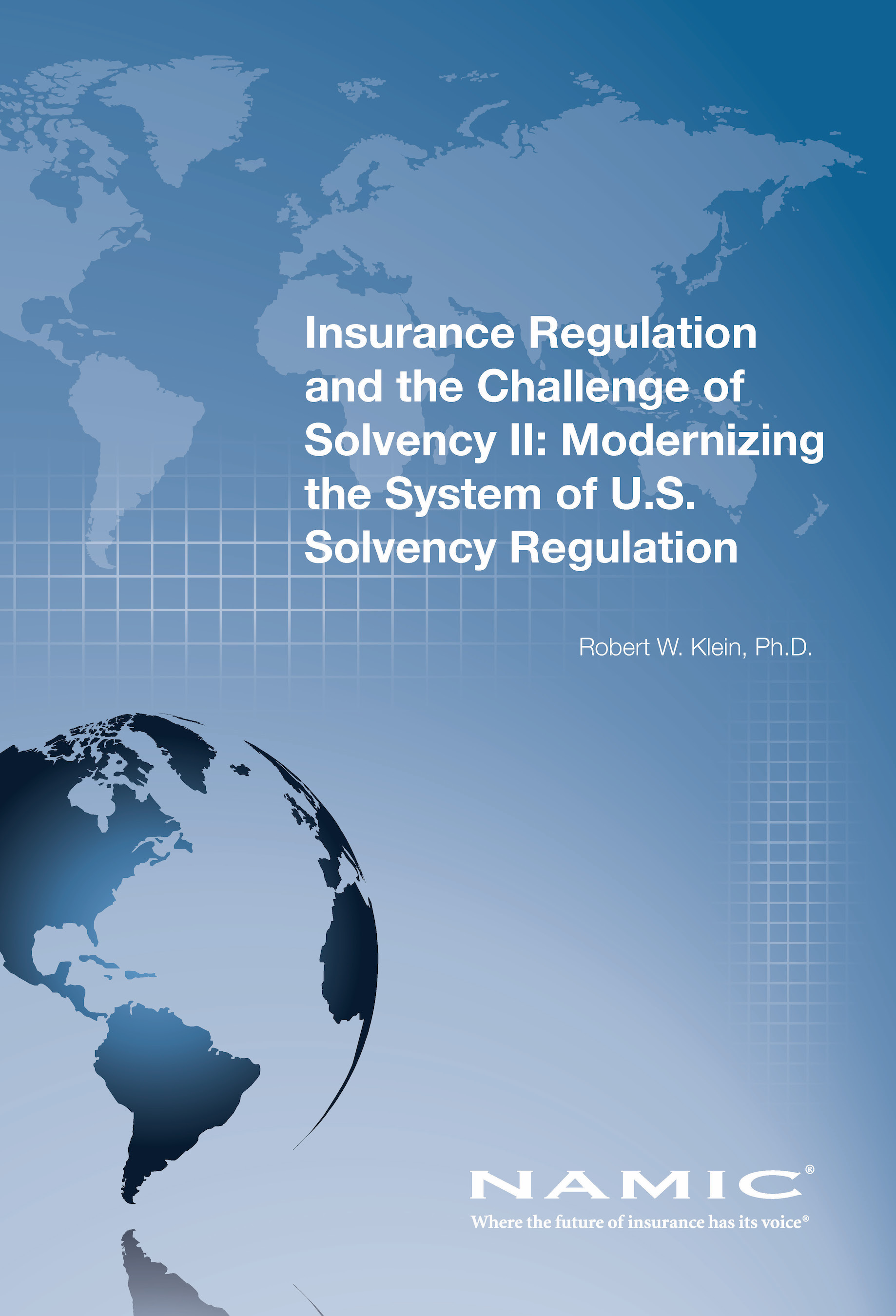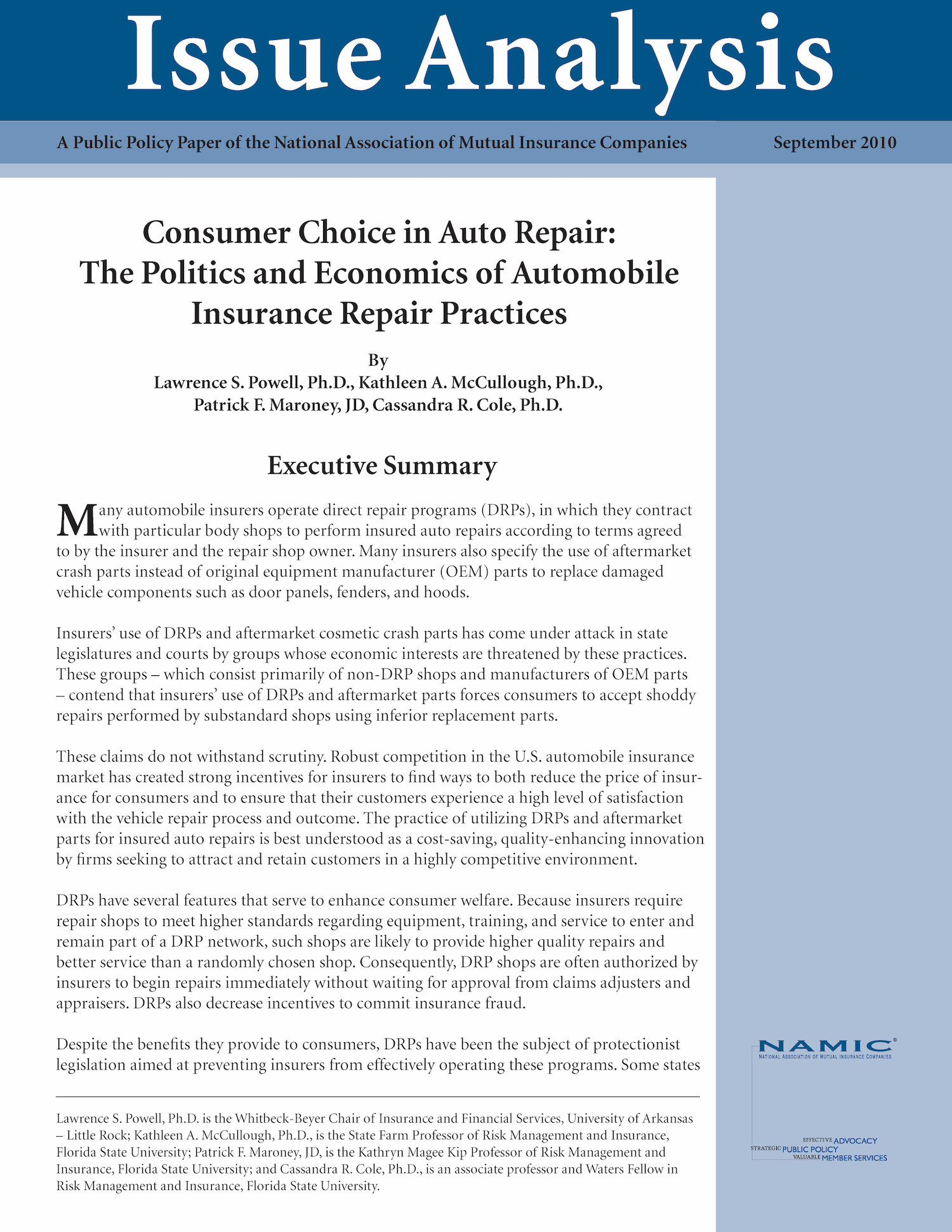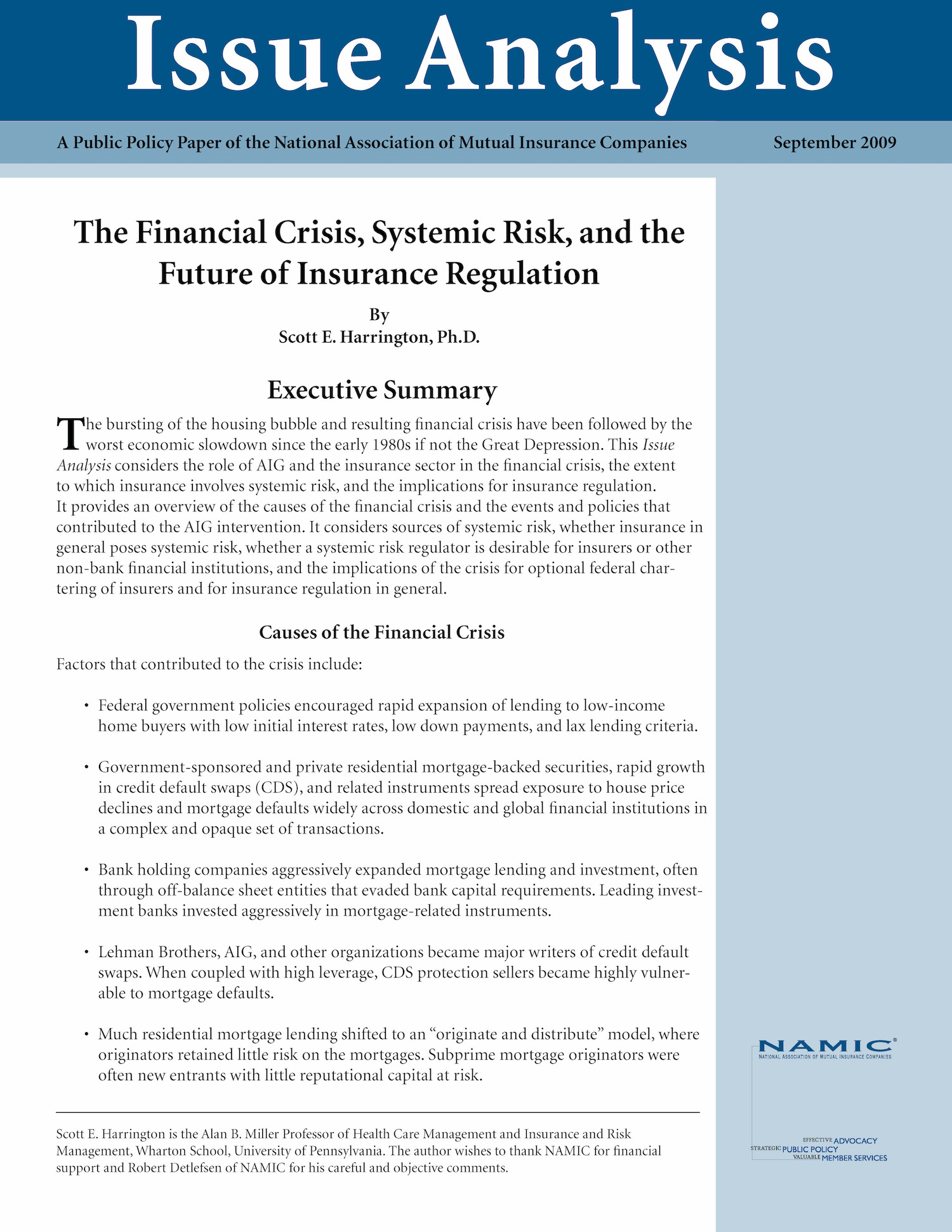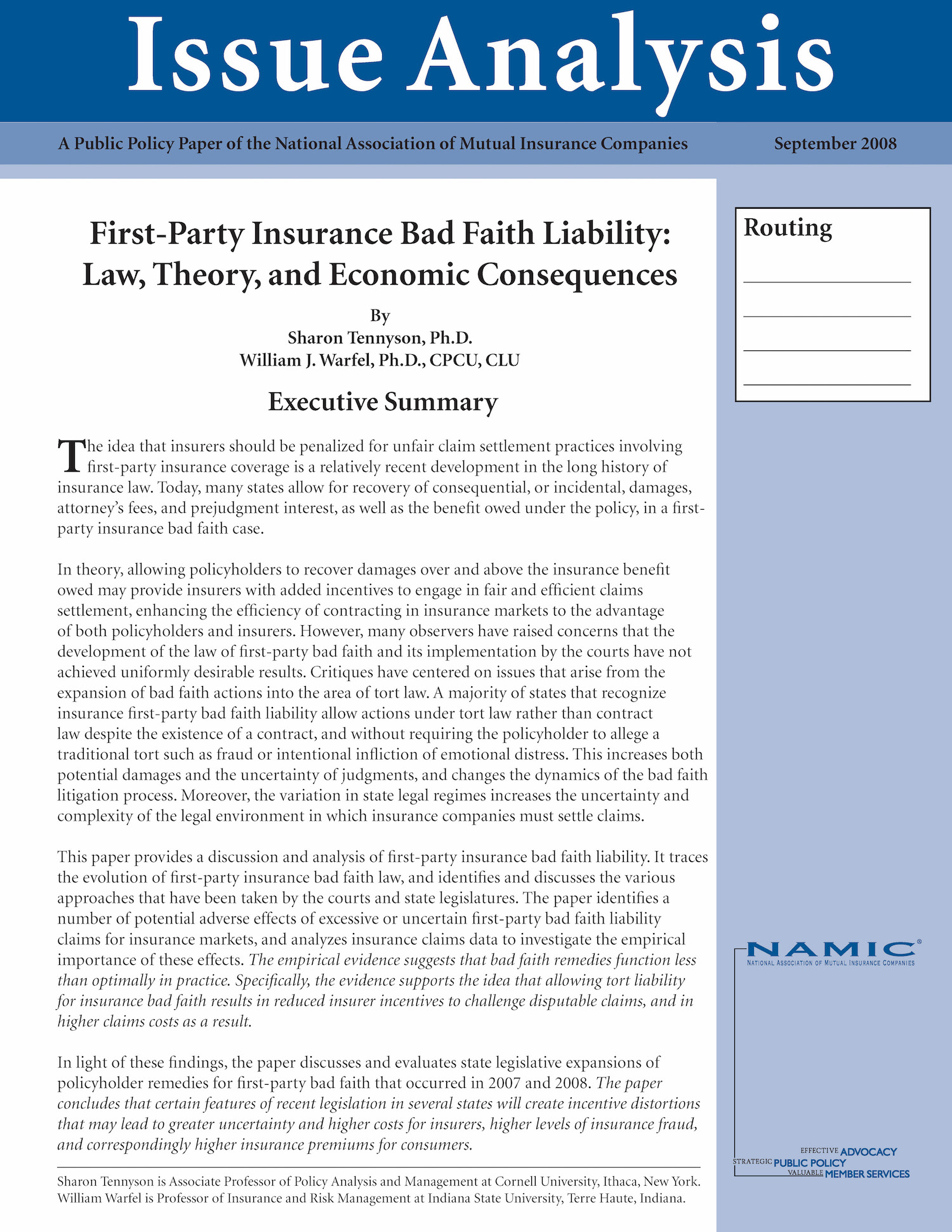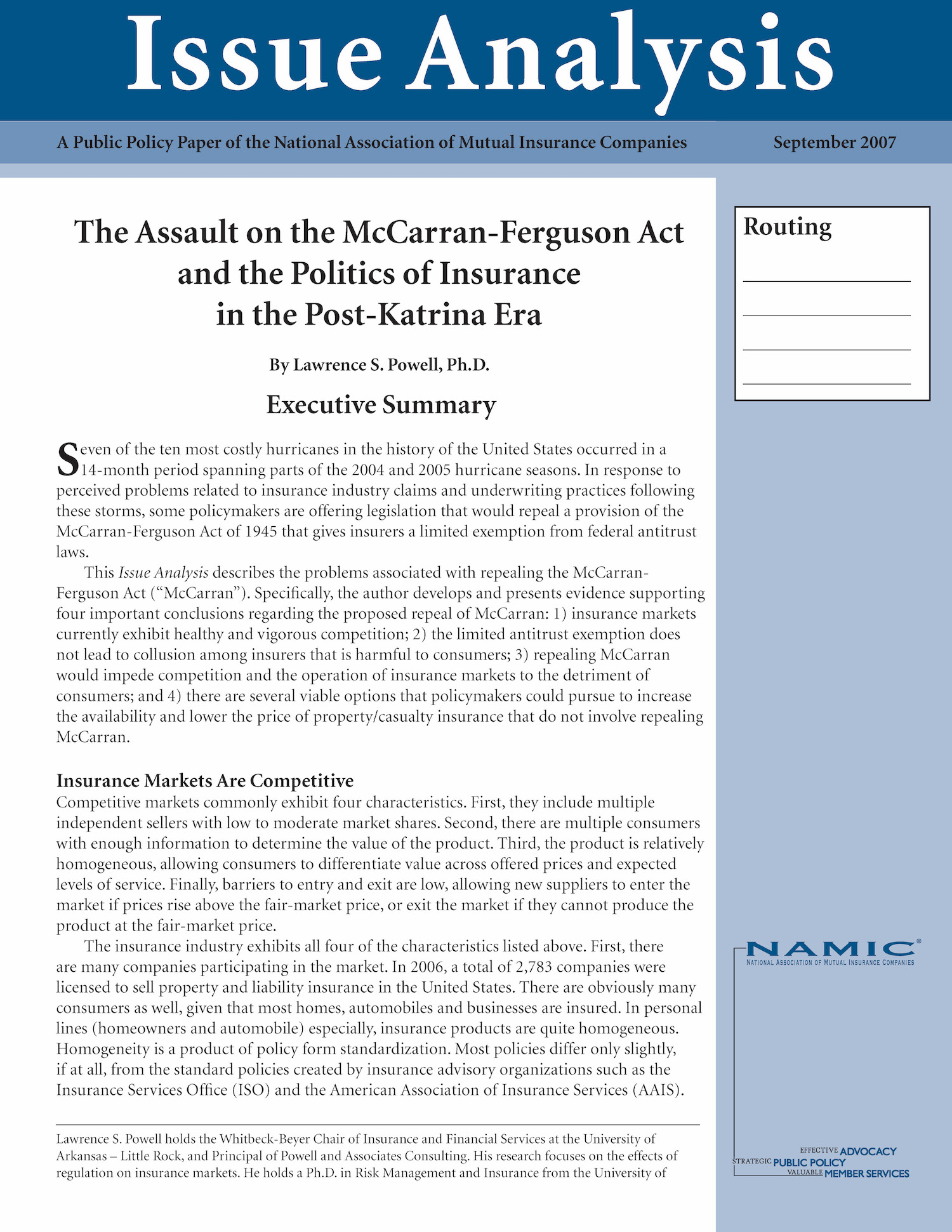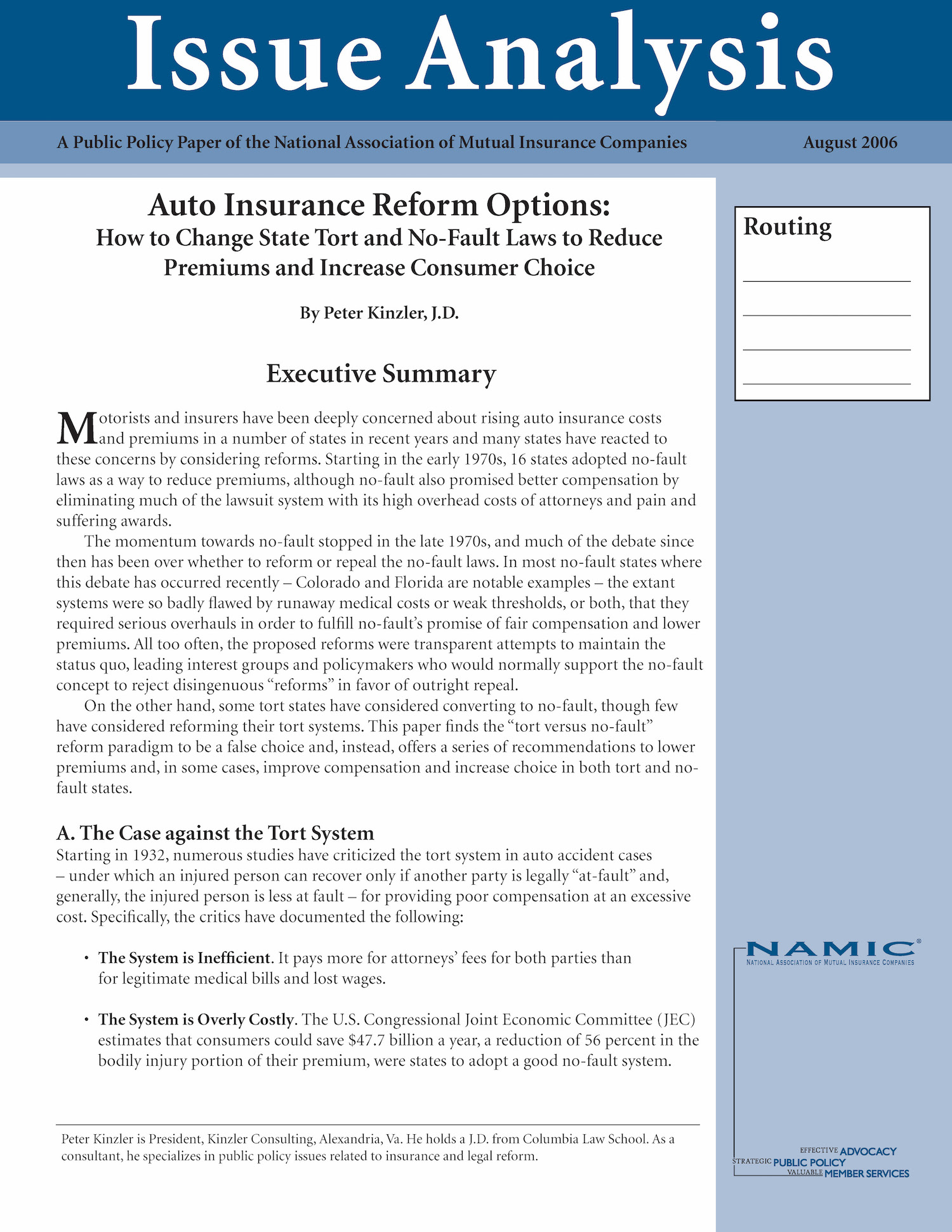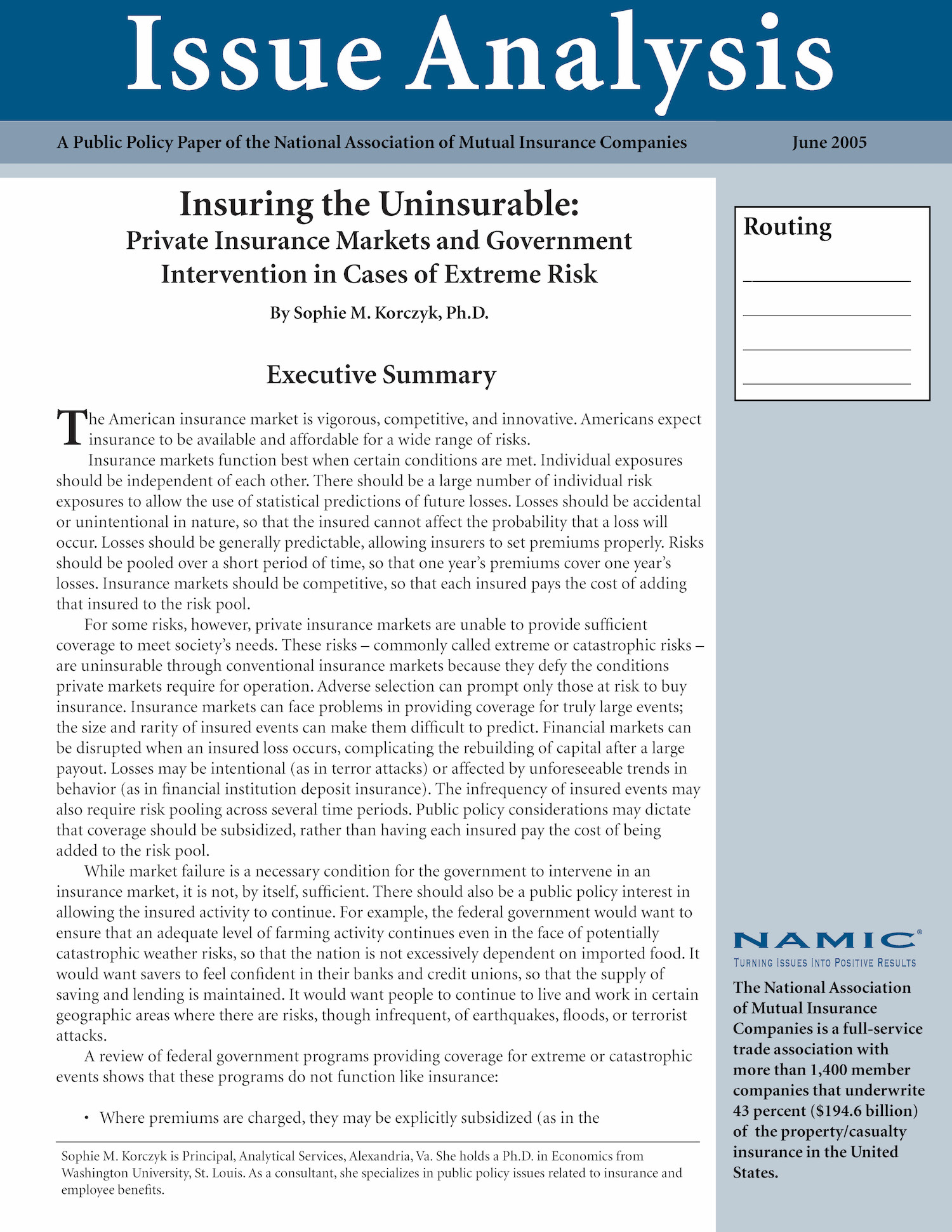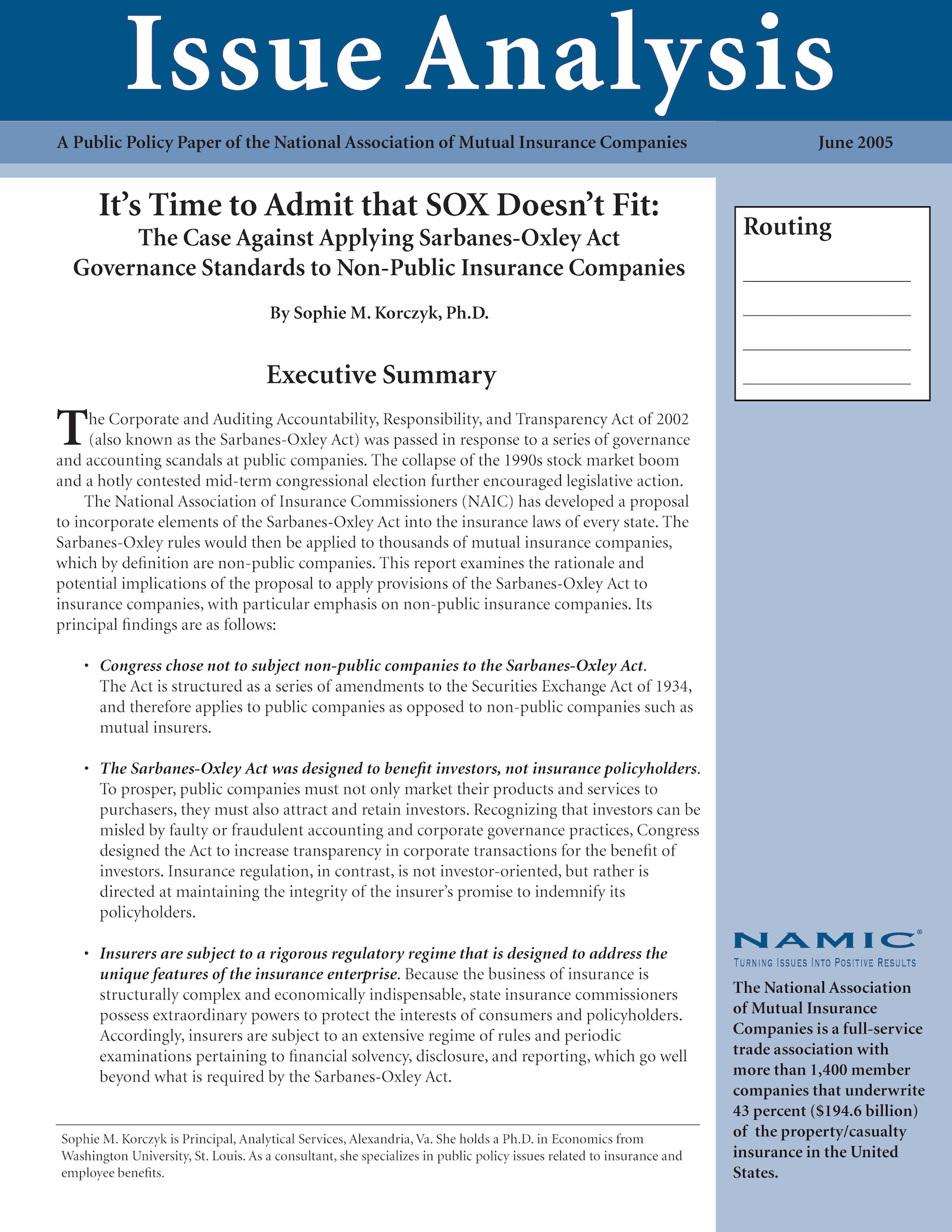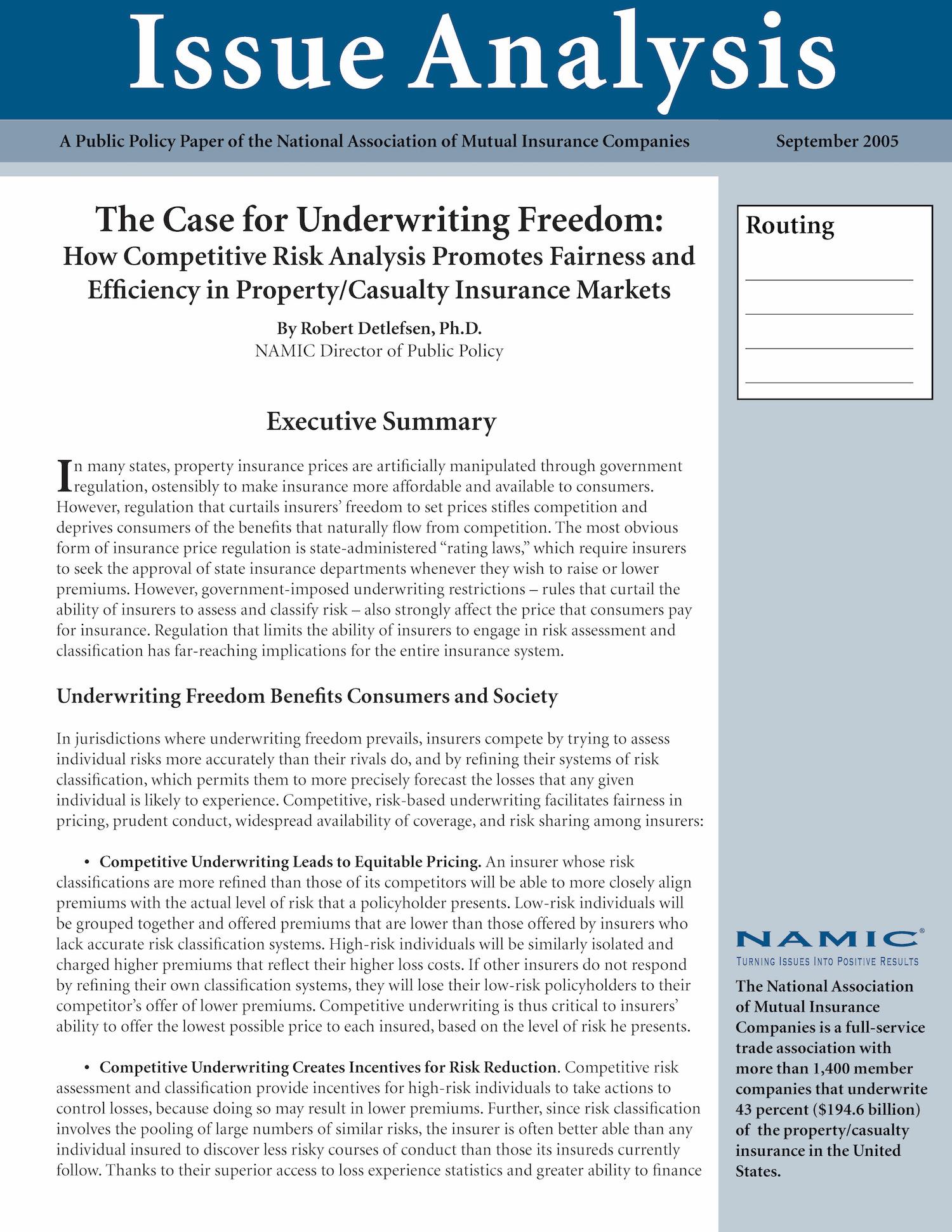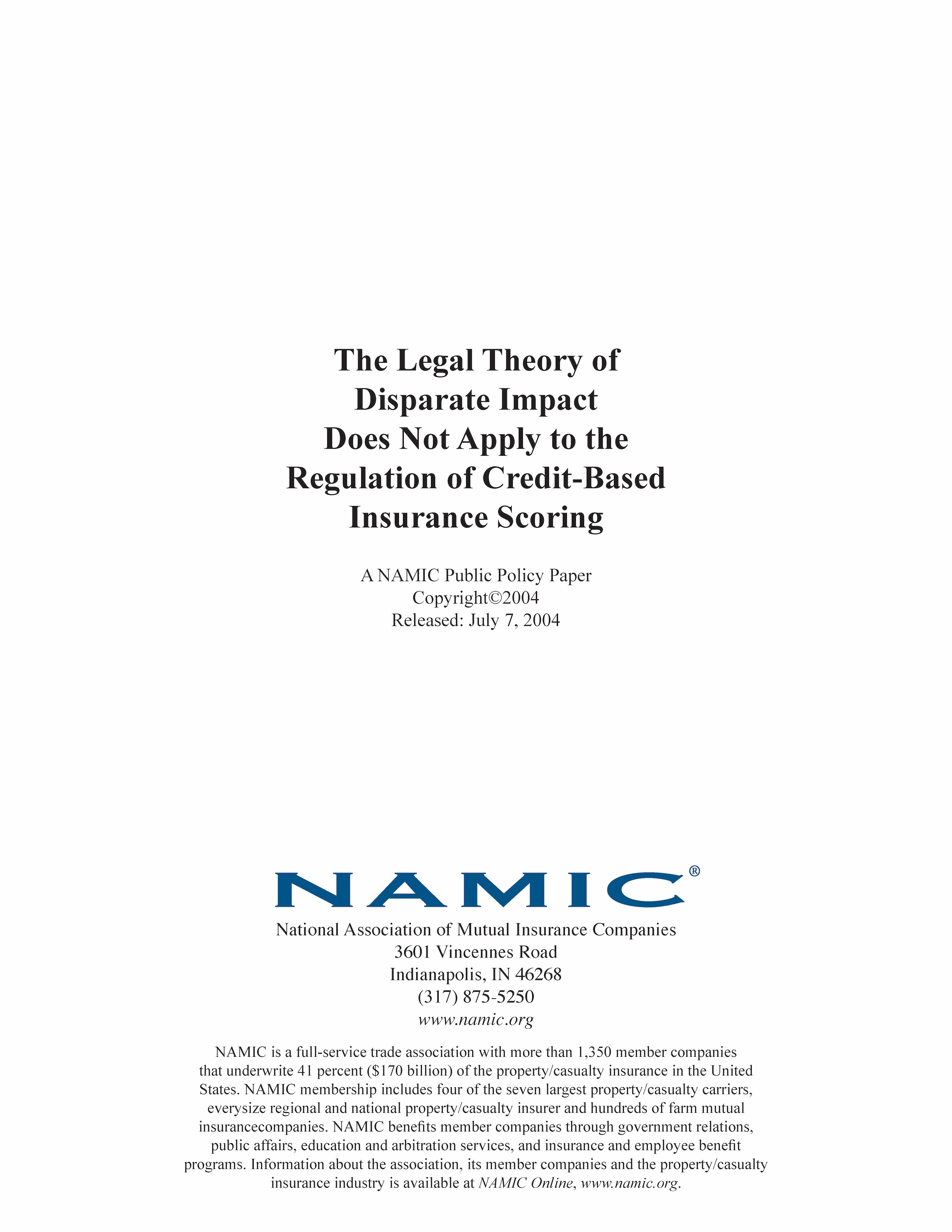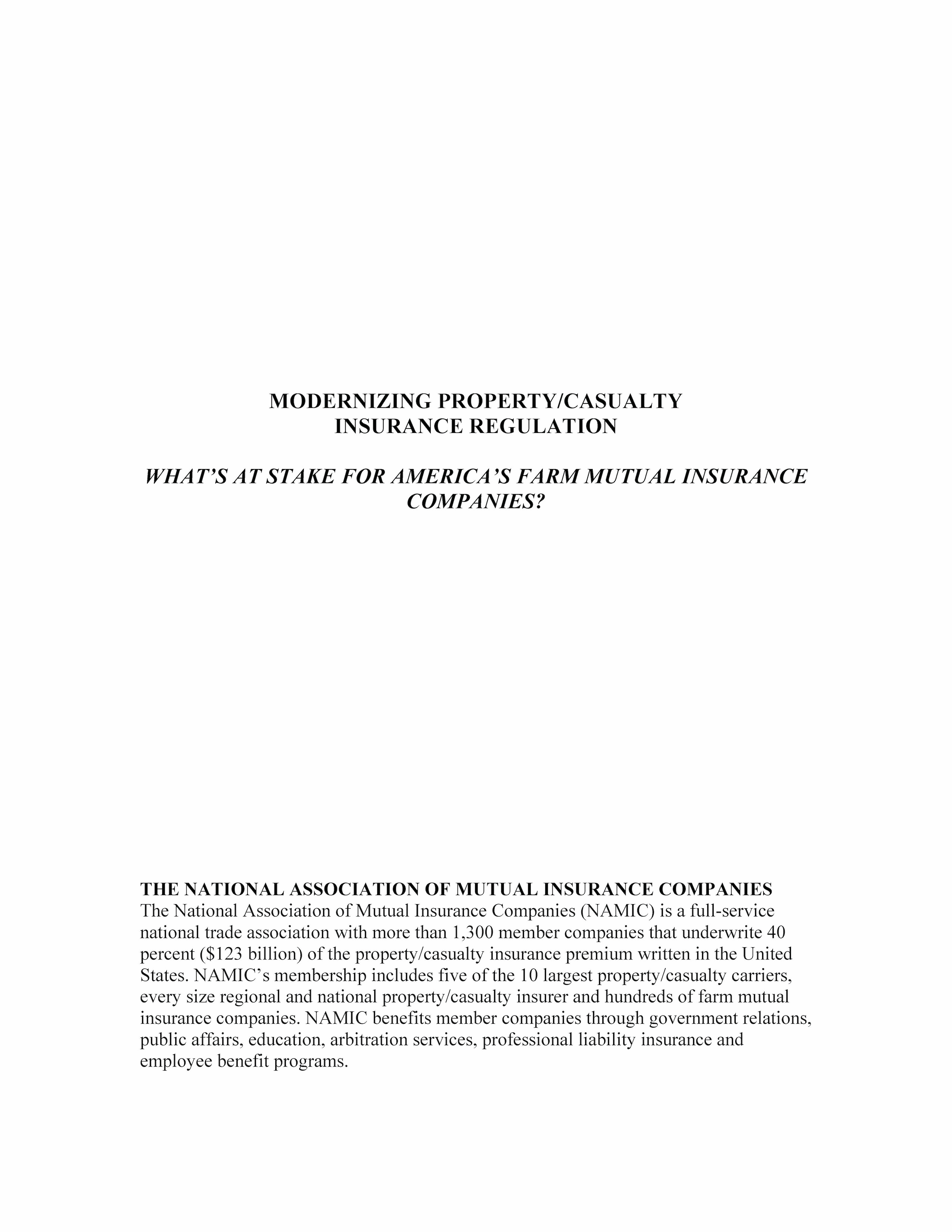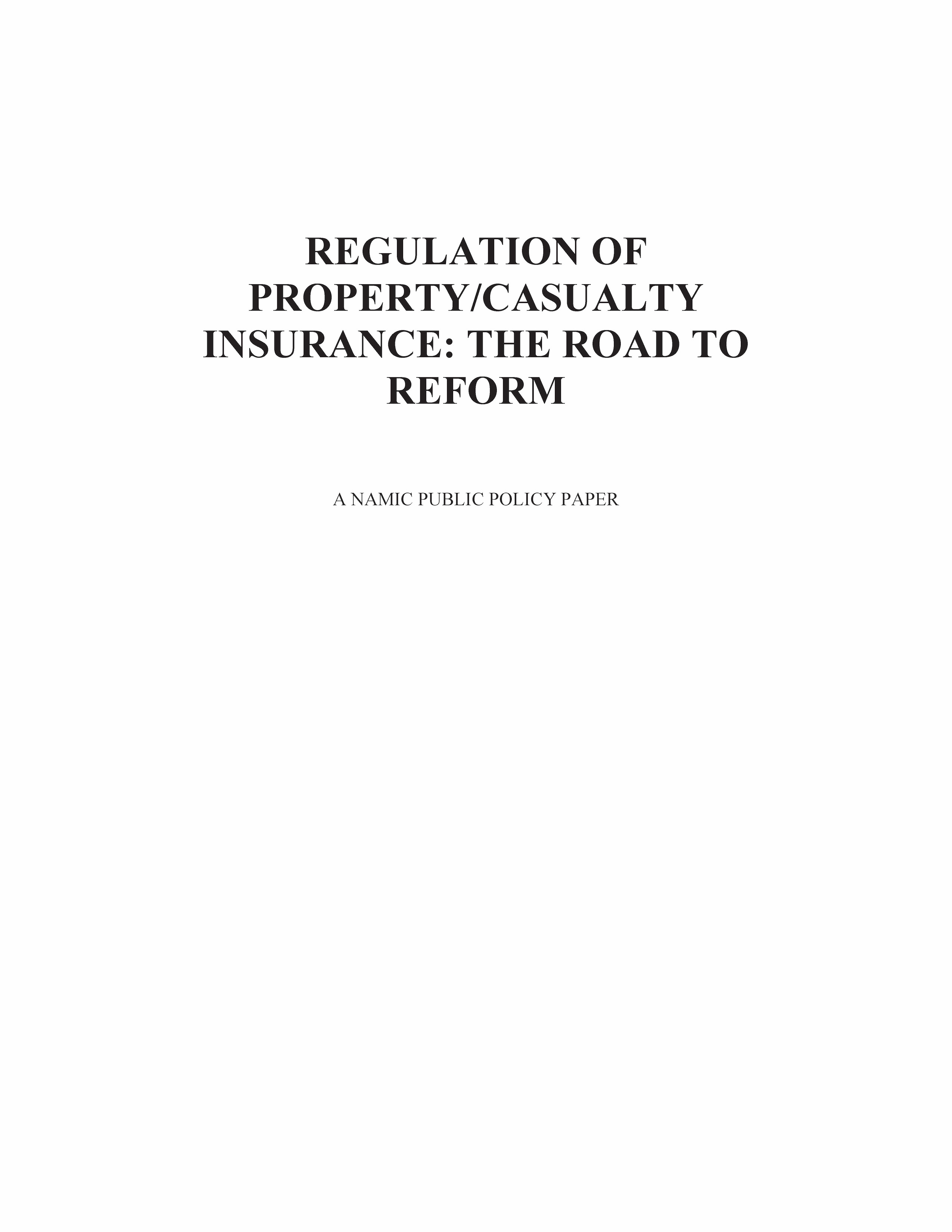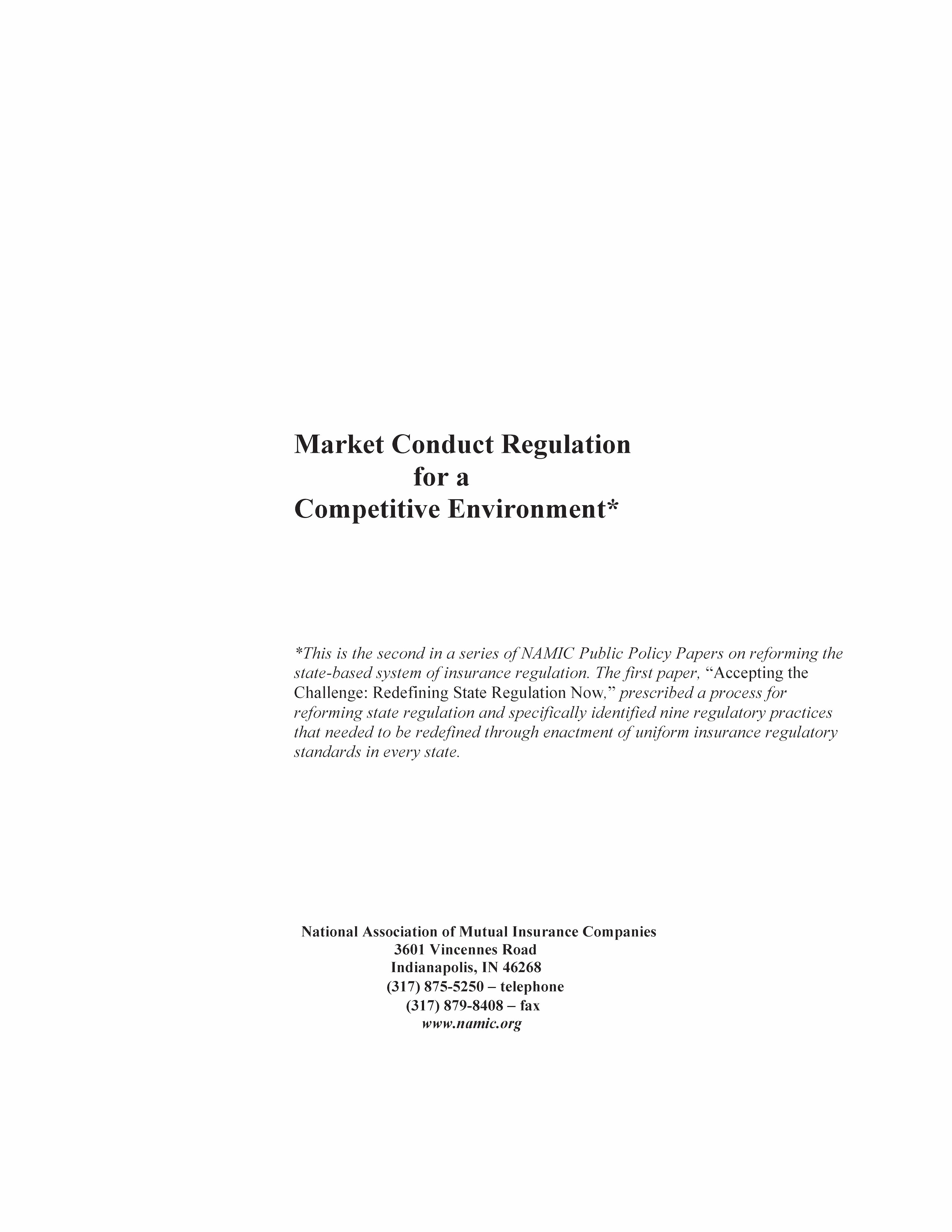Public Policy Papers
Issue Analysis Papers
Financial Examinations in the Post-Covid Era (PDF)
As regulators and insurers continue to find their way in this evolving environment, this paper explores the history of financial examinations; the introduction of the risk-focused approached that ushered in the concept of branded risks; cost drivers such as duplication and outsourced regulation; and some potential solutions to curbing ever-increasing exam costs. This paper also shares ideas for how to make an exam a better value proposition for the company being examined.
(Published 09/12/2024)
Insuring The Future: Beneficial AI Use Cases In The Insurance Industry (PDF)
The property/casualty insurance industry is currently experiencing unprecedented times – navigating a new era of risk and grappling with how to utilize and leverage rapid technological advancements. In terms of risk, property/casualty insurers are experiencing the confluence of extreme weather, inflation and economic uncertainty, legal system abuse, and regulatory challenges. Extreme weather events are increasing in frequency and intensity, and more people are moving into areas considered to be high risk for natural catastrophes. Though the inflation rate declined to 3.4 percent at the end of 2023, after peaking at 9 percent in the summer of 2022, inflation in areas most closely aligned with insurance costs has not slowed at the same pace as general inflation. In terms of legal system abuse, the industry has experienced a rise in class action lawsuits coupled with nuclear verdicts and third-party litigation funding, driving up costs for both insurers and consumers. Finally, insurers are experiencing numerous challenges throughout the regulatory process.
(Published 06/28/2024)
Insuring The Future: Electric Vehicles (PDF)
While interested stakeholders and government agencies aggressively push a future where electric vehicles (EV’s) replace traditional internal combustion engine powered cars and trucks, as of 2023 fewer than 1 percent of vehicles on U.S. roads are EV’s. While that number is growing quickly as manufacturers expand options and features, many questions remain unanswered regarding the realities of EV capabilities, consumer appeal, and the risks they create.
This issue analysis seeks to assist policymakers by separating fact from fiction where EV’s are concerned to provide a more realistic understanding of these vehicles, including the opportunities and risks they create, as well as their potential safety impacts for owners, passengers, and other road users. The future of American transportation will certainly include an increasing number of EV’s; NAMIC members are committed to remain policyholders’ indispensable partners in conversations about protecting their vehicles and families riding in them.
(Published 01/22/2024)
Social Inflation – Legal System Abuse: Observations and Solutions to Support the Right to Fair and Impartial Dispute Resolution (PDF)
The term "social inflation" describes a trend of dramatic increases in costs and verdicts associated with civil litigation that outpaces general economic inflation without significant change in legal or factual bases to support it. Social inflation's causes are complex. Its damaging consequences are palpable for businesses, consumers, and the rule of law. Factors that contribute to social inflation include third-party litigation funding, attorney advertising, and nuclear/extreme non-economic damage verdicts to name a few. The Defense Research Institute whose attorney members are on the front lines of this concern by defending parties to litigation claims along with NAMIC have teamed up to discuss these concerns and provide potential solutions or thoughts on the matter.
Real data proves it exists. The U.S. Chamber of Commerce's Institute for Legal Reform finds that U.S. tort costs, which reached about $443 billion in 2020, were equivalent to 2.1 percent of GDP. Costs had steadily increased at an average annual rate of six percent from 2016 to 2020, outpacing the growth in inflation and GDP over the same period. The Institute for Legal Reform found that for jury verdicts of $10 million or more, the median verdicts increased by 27.5 percent from 2010 to 2019, far outstripping inflation of 17.2 percent over the same period.
These turbulent times are revealing negative shifts in the perceptions of business defendants among jury-eligible people. The idea of a level playing field for business defendants is threatened. Social inflation drives up the length, cost, and outcomes in civil cases. Public policymakers and other stakeholders should take note of the overwhelming influence social inflation factors are causing in our litigation system including conflicts of interest, speculation on litigation, jury pools being tainted, larger costs everyone must bear, and a de-linkage to reasonable and rational litigation dispute resolution.
(Published 02/03/2023)
The Candid Costs of Car Ownership (PDF)
Despite numerous predictions of the demise of private passenger autos, there were more than 283 million vehicles on U.S. roads in 2022, and the number of vehicle miles traveled has surpassed pre-COVID statistics. More than 76 percent of Americans use their cars to commute between home and work, and the average American will spend 51 minutes per day behind the wheel – 13 full days of driving.
With record numbers of cars and drivers come record numbers of crashes and fatalities, which combined with other significant cost pressures and inventory shortages, have driven the cost of automobile ownership to all-time highs. These unprecedented expense levels have a subsequent effect on NAMIC members’ efforts to provide financial protection for auto policyholders. This issue analysis examines six primary factors driving the increased cost of auto ownership to better inform the public and policymakers as they consider their future actions related to vehicles and related insurance decisions.
(Published 01/17/2023)
Cost Drivers: How Riskier Roads, Rising Repairs, and Reckless Driving are Increasing Insurance Costs (PDF)
As our country and the world continue emerging from the fog of COVID-19, the cost of auto insurance will be squarely in the headlights for many policymakers at the federal, state, and local levels for some time to come. This interest would have developed with or without a global pandemic, but as with many products, COVID-19 has highlighted, accelerated, and exacerbated many existing and emerging challenges in auto insurance. Despite insurers voluntarily providing more than $14 billion in relief to consumers, waiving fees, suspending exclusions, and pausing cancellations during the pandemic, consumer advocates, elected officials, and some regulators continue to focus on auto insurers for alleged “windfall” profits while failing to recognize the last decade of losses in a low-interest rate environment. In fact, a robust review of historical and ongoing trends in the market should give policymakers significant pause before embracing any hasty, unnecessary actions that will disrupt markets and disproportionately hurt exactly those constituents they are seeking to help.
The stark reality is that the rising cost of auto insurance is a downstream symptom rather than the root cause of a problem, and efforts to further legislate or regulate auto insurer practices in hopes of lowering costs will not be successful because they are not focused on these root causes. Like many other industries, modern auto insurance carriers find themselves in the unenviable position of having most of their costs determined by external forces they can do very little to control.
This paper provides an overview of the cost of modern auto insurance, identifies the most prominent pressures driving current costs, and suggests several policy recommendations for consideration by legislators as they establish rules for the future of financial protection on the roads for all Americans.
(Published 12/14/2021)
Closing the protection gap for flood risk. How can U.S. communities better guard themselves against the disruptive – and very real – threat of floods? (PDF)
With each passing year, the nation’s collective vulnerability to flooding grows. The cost of these events continues to increase – as does the risk of property damage. According to data from First Street Foundation, annual losses on homes with a 1 percent chance of flooding will increase by 61 percent – to $32 billion – over the next 30 years.
Most homeowners lack the appropriate safeguards, putting their economic health – and the financial stability of their communities – at risk. The solution to such a multifaceted challenge must be equally dynamic, with meaningful shifts in risk awareness, public policy, mitigation and resilience measures, and advancement of a private flood insurance market.
This paper examines the nature of flood risk, its economic consequences, how policymakers can help promote the importance of resilience and mitigation, and the role of insurance in alleviating the impacts felt by individuals and communities after a flood.
(Published 06/25/21)
Cannabis Conundrum: The Intersection of Property/Casualty Insurance and Cannabis-Impaired Driving (PDF)
The proliferation of cannabis legalization and its widespread medical and recreational use by millions of Americans presents a host of new challenges for law enforcement, public safety officials, lawmakers at all levels of government, and property/ casualty insurers. While neither a supplier nor an end user, the insurance industry still finds itself squarely in the middle of this complex legal landscape, with many more questions than answers, and it must think through the best ways to be a good partner in the development of practical public policy solutions moving forward.
(Published 05/10/21)
Matching Rate to Risk: Analysis of the Availability and Affordability of Private Passenger Automobile Insurance (PDF)
Competition in auto and home insurance markets helps to ensure fair prices and broad availability of coverage. Further, insurance is closely regulated in the U.S. and this regulation provides additional safeguards for consumers. However, consumer groups allege that insurance companies engage in unfair discrimination in their pricing and underwriting activities for auto and home insurance that have disproportionately negative effects on certain groups of consumers or areas. In this paper, Dr. Robert Klein, Ph. D., analyzes data on average premiums, pure premiums, and loss ratios delineated by income quartile for each state to determine how these metrics vary with income.
(Published 02/02/21)
Why Your Insurance Costs What It Does: A Risk-Based Pricing Primer (PDF)
As an industry, insurance affects multiple parts of every American citizen’s daily life and provides financial safety for more than 80 million homes and 200 million vehicles each year, but sadly there is very little understanding among consumers of what insurance is or how it is priced. This introductory paper seeks to provide a simplified, straightforward, user-friendly explanation on the core principle underlying the business of insurance: Risk-based pricing.
(Published 01/08/21)
COVID-19 Workers’ Compensation Presumptions: A Survey and Analysis of Their Indelible Impact (PDF)
With the onset of COVID-19, a new discussion and public policy dynamic have emerged that the insurance industry has had to come to grips with over the spring and summer months of 2020 and beyond. The results of this unprecedented discussion and resulting activity may forever alter and shift the workers’ compensation paradigm in numerous ways. The intent of this paper is to explore the issues, the public policy activities, the resultant measures to address, and to briefly analyze the impacts that the hyper-reactive atmosphere the COVID-19 pandemic has created for the employer and insuring community.
(Published 12/01/20)
Updated Environmental, Social, and Governance Considerations for Property/Casualty Insurance (PDF)
Following up on NAMIC’s 2019 introductory ESG paper, this new white paper further defines the movement for greater social responsibility for companies and suggests how mutual insurance company senior management and boards of directors can better consider such actions in today’s tumultuous climate while maintaining the requisite duty of care and loyalty to their companies to which they are legally and morally bound.
(Published 10/19/20)
The Next Iteration of Holding Company Regulation — What Does it Look Like and What Should be Different? (PDF)
This paper examines recent changes to holding company laws and regulations and how the new GCC tool fits in within the existing framework. The paper includes a brief summary of recent holding company changes, followed by a review of the breadth of financial and risk information that lead state regulators already receive as part of their oversight duties. Finally, the paper concludes with a discussion about alternatives the NAIC should consider to tailor holding company regulation to the size and complexity of the IHCS.
(Published 09/30/20)
Liability Standards for Automated Vehicle Shared-Driving Crashes (PDF)
Determining exactly what happened in a car crash is often very difficult. That determination will be exponentially more difficult in crashes where a car has a human driver and automated driving capabilities. Existing legal standards for allocating liability in car crashes are not designed to consider non-human “drivers”; and the absence of specific guidance and definitions will leave legislators, regulators, judges, and juries ill-equipped to make important determinations in this space. Auto insurance companies will benefit from a greater understanding of how the proper application of local legal standards and duties to such vehicles will ensure that actual losses are evaluated better and recovery potential can be improved.
(Published 06/11/20)
The State Rating Statutes and Constitutional Policymaking: Causation and Disparate Impact Standards in NAIC’s Draft White Paper (PDF)
Nat Shapo, partner at Katten Muchin Rosenman LLP and former director of the Illinois Department of Insurance and National Association of Insurance Commissioners executive committee member, outlines significant concerns regarding the NAIC Casualty Actuarial and Statistical (C) Task Force’s draft Regulatory Review of Predictive Models White Paper. Among those is that it directs regulators to require a showing of causation/intuitiveness for, and to apply a disparate impact/proxy variable standard to, all rating factors with no basis in controlling law.
(Published 03/06/20)
CCPA: A Model to Follow or Avoid? Questions to Consider (PDF)
Consumer data security and privacy protections have been a long-standing and top concern for insurance companies. Recently, there has been a flurry of activity in the privacy space, with the most widely discussed efforts happening in California. This paper provides a brief consideration of the California Consumer Privacy Act from an insurance industry perspective. It is not intended to address the specific requirements for compliance or implementation, but to instead raise important questions and issues for discussions of whether it is timely for other states to consider CCPA as a model for their privacy framework.
(Published 02/21/20)
Responsibility Assessment Standards for Conditional Automation/Dual Control Vehicles (PDF)
There are tremendous efforts underway to develop and deploy automated vehicles, utilizing complex computer and mechanical systems to perform driving operations. In this paper NAMIC proposes the need for standards that define what Conditional Automation/Dual Control Vehicles can and cannot do before they are operated on the public roads.
(Published 01/08/20)
The Deleterious Effects Expansive Bad-Faith Litigation Has on Insurance Markets (PDF)
An at times antiquated concept of “bad faith“ still thrives in many U.S. jurisdictions and its employment continues to grow in others. General acceptance and complacency concerning these allegations should not stifle a continuing debate as to the efficacy of such causes of action, which are in many cases redundant to state insurance regulation. While legitimate claimants who are routinely and efficiently paid by insurers on a timely basis, the paper seeks to point out that as “bad-faith“ claims have developed over the last century, some of the rationale for their existence is no longer operative.
(Published 12/12/19)
Getting Value Out of Your Next Financial Examination (PDF)
Financial solvency regulation in the insurance industry has undergone monumental change over the last decade, and it is the financial examination that companies undergo every three to five years that has been impacted the most. As regulators and insurers alike seek to find their way in a post-financial crisis environment, this paper explores the history of the financial examination, the introduction of the risk-focused approach, cost drivers such as duplication and outsourced regulation, and some potential solutions to make the financial examination a better value proposition for the company being examined.
(Published 12/01/19)
Insurance Drone Operations: 2020 Law and Regulation (PDF)
Law and regulation of drone operations for insurance companies and other operators is complex and evolving. As permissible drone operations are better defined and proliferate, attendant questions of the rights of people and property subject to drone flights will become more and more of an issue. As insurance drone operations “do’s” and “don’ts” develop nationally and locally, this snapshot of rules and predictions of future developments is offered for insurance companies to better understand the terms and conditions in which they may operate drones.
(Published 10/31/19)
CECL: How an Obscure Accounting Change Could Negatively Impact Insurers (PDF)
The Financial Accounting Standards Board issued an accounting standard update in June of 2016 that introduced the current expected credit-loss, or CECL, methodology for estimating allowances for credit losses. The standard takes effect for SEC filers for fiscal years, and interim periods within those fiscal years, beginning after December 15, 2019. All other organizations will have an additional year for implementation. There are many things property/casualty insurance companies need to be aware of in relation to the new CECL standard, and this paper attempts to describe how FASB arrived at its decision to introduce an expected credit-loss concept and explain how that applies to mutual insurance companies.
(Published 04/18/19)
Understanding the Terrorism Risk Insurance Program (PDF)
Since the events of September 11, 2001, the federal government has developed a robust and sophisticated counter-terrorism apparatus that has thus far succeeded in preventing large-scale terrorist attacks on the United States homeland. However, the threat of terrorism is continuing to evolve amid a changing, unstable, and dangerous international environment. This paper explores the TRIA program, a risk-sharing model between insurers, policyholders, and the federal government that has acted to create space for a robust private market for terrorism insurance to form where it would not have otherwise.
(Published 03/26/19)
Curbing a Questionable Practice: A Survey of Public Policy Measures to Address Concerns Surrounding Litigation Funding (PDF)
Litigation funding1 has developed into a significant public policy issue of concern for insurers and others affected by litigation over the past twenty years. NAMIC and other organizations have worked to secure meaningful public policy measures aimed at better understanding and ultimately curbing the problems associated with litigation funding. The purpose of this paper is to better understand the remaining challenges and opportunities by surveying some of the recent public policy developments in the litigation funding space.
(Published 01/28/19)
Group Capital and U.S. Insurance Regulation (PDF)
A better understanding of why the U.S. insurance regulators and industry cannot agree to an EU-type capital requirement may provide some context for meaningful discussions at the G20, the FSB, Congress, and among other policymakers before such a standard is adopted. In this paper, NAMIC provides background about the U.S. insurance supervisory system and group capital efforts at the IAIS, National Association of Insurance Commissioners, and Federal Reserve to outline the real need for a directional change at the IAIS.
(Published 12/21/18)
Developments in Insurance Company Drone Use (PDF)
This third white paper in the continuing series provides a snapshot of the way insurance companies use drones to provide insurance services. This overview also aims to give insurers an understanding of the developments that provide opportunities for, and obstacles to, drone use. The paper concludes with a review of the important advocacy efforts that have been undertaken to expand those opportunities and overcome the obstacles.
(Published 12/10/18)
Cannabis: From Criminality to Commercial Enterprise (PDF)
"Cannabis: From Criminality to Commercial Enterprise" explores the issues and complexities at the intersection of the insurance industry and the burgeoning cannabis industry, including a review of the legal landscape surrounding it. While the legalization of marijuana can be a politically divisive subject, there is value in insurers developing an understanding of how the issues at play will affect their companies.
(Published 11/01/18)
Understanding the Evolving Cybersecurity Standards Landscape for Insurers (PDF)
The amazing benefits of a technologically advanced and interconnected society have not been attained without the price of sobering exposure to substantial and even potentially catastrophic harm. As Congress, state legislatures, the National Association of Insurance Commissioners, and state insurance regulators have proposed and/or adopted a variety of public policy measures affecting insurers in response to the cybersecurity threat, it is worth assessing how cybersecurity regulation efforts should and do function within the broader scheme of insurance regulation.
(Published 07/12/18)
Validating Safety: The Next Phase in Developing Automated Driving Systems (PDF)
The development of Automated Driving Systems (ADS) may be the most consequential transportation issue of our time. New technology and novel service strategies promise faster and better mobility that will be less expensive, and more environmentally friendly. Spring boarding from existing and widely accepted “assisted driving” systems such as cruise control, ADS developers promise a wider array of functions from greater driver assistance to vehicles that will perform every driving operation with no human intervention.
(Published 05/18)
Blockchain: What Possibilities Lay Ahead for Property/Casualty Insurers (PDF)
The potential of blockchain to revolutionize the business of insurance is commanding a great deal of attention within the industry. Now is the time for property/casualty insurance professionals to start looking at the possibilities for future application of this technology to securely share information with policyholders, competitors, suppliers, or others.
(Published 03/18)
Insurance And The Evolution of Automated Driving (PDF)
Fully autonomous cars are likely decades away. But as the line between car and driver blurs, NAMIC examines the questions surrounding autonomous vehicle technology, and what it means for the insurance industry.
(Published 04/17)
Unmanned Aircraft: Defining Private Airspace Driving (PDF)
You can have your neighbor removed from your yard, but according to the Federal aviation Administration you cannot stop his drone from flying directly over your property. As the Use of unmanned aerial systems grows more commonplace, Tom Karol, NAMIC general counsel – federal, explains how the FAA’s broad interpretation of navigable airspace for drones has overturned a centuries-old understanding of property rights and could eliminate many privacy protections.
(Published 03/17)
What It Means to be Mutual (PDF)
Lawrence S. Powell, Ph.D., executive director of the Alabama Center for Insurance Information and Research, sets out to describe how mutual insurance companies differ from other insurance companies in this paper that reviews numerous peer-reviewed academic journal articles and books, and insurance industry data from the National Association of Insurance Commissioners database. What he found was several distinct mutual-insurer traits that appeared consistently in his analysis.
(Published 03/17)
Best Practices for Regulating Property Insurance Premiums and Managing Natural Catastrophe Risk in the United States (PDF)
As a response to the Federal Insurance Office’s 2013 report that called on state-level policymakers to identify and implement best practices with respect to insurance rate regulation and natural disaster mitigation, Patricia Born, Ph.D., Florida State University, and Robert Klein, Ph.D., Georgia State University, examine the features of state regulatory environments that serve either to mitigate or exacerbate the adverse effects of natural catastrophes on property insurance markets. The paper addresses four areas of regulation: regulation of rates and underwriting practices; administration of residual market mechanisms; regulation of insurance policy provisions; and regulation of claim settlement practices.
(Published 11/15)
Unmanned Aerial Systems/Drones - Regulation, Liability and Insurance Requirements (PDF)
With commercial use of unmanned aerial systems, more commonly known as drones, expected to rapidly increase, Tom Karol, NAMIC general counsel – federal, examines the often overlooked and as yet unresolved questions about how such systems would be covered for loss, damage and liability, and how this emerging technology could also impact insurer operations. The regulatory structure for commercial drone use – in terms of not only how drones can be used but also who is allowed to use them for commercial purposes – is still in the early stages of its development. In the paper Karol outlines how decisions from federal, state, and even local policymakers could impact insurance coverage for UASs.
(Published 02/15)
Unnecessary Injury: The Economic Costs of Imposing New Global Capital Requirements On Large U.S. Property and Casualty Insurers (PDF)
This paper, by Robert Shapiro, Ph.D., offers a look at the potential costs of current efforts toward globalization of financial standards that began in the wake of 2008-2009 financial crisis. Based on his extensive research, Dr. Shapiro projected the potential costs of such standards for consumers at as much as $109 in increased homeowners insurance premiums, and found that the standards could slow the growth of insurance offerings by as much as $7.3 billion each year. Shapiro, the chairman of Sonecon, LLC, a private firm that advises U.S. and foreign businesses, governments, and non-profit organizations on market and political conditions affecting economic policy and security matters, and has served as an advisor to former President Bill Clinton and former British Prime Minister Tony Blair, among others.
(Published 11/14)
Insurance Regulation and the Challenge of Solvency II: Modernizing the System of U.S. Solvency Regulation (PDF)
Significant changes in insurance regulatory policies and practices at an international level, including the European Union’s Solvency II directive, have prompted U.S. regulators to reconsider the current system of insurer solvency oversight. This paper provides a comprehensive review and analysis of the current U.S. system of solvency regulation, and describes and assesses the five principal components of the National Association of Insurance Commissioners’ Solvency Modernization Initiative. This is followed by an evaluation of the NAIC’s risk-focused surveillance framework and current U.S. regulatory policies and practices with respect to insurance prices, products, and market conduct. The paper concludes with a summary of the key findings in each of these areas and their implications for the future of insurance regulation in the U.S.
(Published 11/12)
No-Fault Insurance at 40: Dusting Off an Old Idea to Help Consumers Save Money in an Age of Austerity (PDF)
In 1971, Massachusetts became the first state to implement a no-fault law, but since 1975, no state has enacted a similar law. The authors of this paper argue that no-fault was never given a chance in its intended form, and the failure of the state laws to lower premiums lies not in the no-fault concept itself, but because the laws were structured in such a way as to undermine the law’s effectiveness. The authors also argue that in a time when government deficits will result in lower benefits and higher costs for Americans on many fronts, property structured no-fault laws – ones that take advantage of the new national health insurance law to reduce medical costs and give consumers the option to elect not to sue for pain and suffering – could enable consumers to save tens of billions of dollars a year.
(Published 12/11)
Consumer Choice in Automobile Repair Practices (PDF)
Insurers’ use of direct repair programs and aftermarket cosmetic crash parts has come under attack in state legislatures and courts by groups whose economic interests are threatened by these practices. These groups – which consist primarily of non-DRP shops and manufacturers of OEM parts – contend that insurers’ use of DRPs and aftermarket parts forces consumers to accept shoddy repairs performed by substandard shops using inferior replacement parts. These claims do not withstand scrutiny. Robust competition in the U.S. automobile insurance market has created strong incentives for insurers to find ways to both reduce the price of insurance for consumers and to ensure that their customers experience a high level of satisfaction with the vehicle repair process and outcome.
(Published 09/21/10)
The Financial Crisis, Systemic Risk, and the Future of Insurance Regulation (PDF)
The bursting of the housing bubble and resulting financial crisis have been followed by the worst economic slowdown since the early 1980s if not the Great Depression. This Issue Analysis considers the role of AIG and the insurance sector in the financial crisis, the extent to which insurance involves systemic risk, and the implications for insurance regulation. It provides an overview of the causes of the financial crisis and the events and policies that contributed to the AIG intervention. It considers sources of systemic risk, whether insurance in general poses systemic risk, whether a systemic risk regulator is desirable for insurers or other non-bank financial institutions, and the implications of the crisis for optional federal chartering of insurers and for insurance regulation in general.
(Published 09/22/09)
First-Party Insurance Bad Faith Liability: Law, Theory, and Economic Consequences (PDF)
The idea that insurers should be penalized for unfair claim settlement practices involving first-party insurance coverage is a relatively recent development in the long history of insurance law. Today, many states allow for recovery of consequential, or incidental, damages, attorney’s fees, and prejudgment interest, as well as the benefit owed under the policy, in a first-party insurance bad faith case. The paper concludes that certain features of recent legislation in several states will create incentive distortions that may lead to greater uncertainty and higher costs for insurers, higher levels of insurance fraud, and correspondingly higher insurance premiums for consumers.
(Published 09/26/08)
The Assault on the McCarran-Ferguson Act and the Politics of Insurance in the Post-Katrina Era (PDF)
Seven of the ten most costly hurricanes in the history of the United States occurred in a 14-month period spanning parts of the 2004 and 2005 hurricane seasons. In response to perceived problems related to insurance industry claims and underwriting practices following these storms, some policymakers are offering legislation that would repeal a provision of the McCarran-Ferguson Act of 1945 that gives insurers a limited exemption from federal antitrust laws.
(Published 09/21/07)
Auto Insurance Reform Options: How to Change State Tort and No-Fault Laws to Reduce Premiums and Increase Consumer Choice (PDF)
Starting in the early 1970s, 16 states adopted no-fault laws as a way to reduce premiums, although no-fault also promised better compensation by eliminating much of the lawsuit system with its high overhead costs of attorneys and pain and suffering awards. The momentum towards no-fault stopped in the late 1970s, and much of the debate since then has been over whether to reform or repeal the no-fault laws. Where this debate has occurred, all too often the proposed reforms were transparent attempts to maintain the status quo, leading interest groups and policymakers who would normally support the no-fault concept to reject disingenuous “reforms” in favor of outright repeal.
(Published 10/04/06)
Insuring the Uninsurable: Private Insurance Markets and Government Intervention in Cases of Extreme Risk (PDF)
For some risks, private insurance markets are unable to provide sufficient coverage to meet society’s needs. These risks – commonly called extreme or catastrophic risks – are uninsurable through conventional insurance markets because they defy the conditions private markets require for operation. A review of federal government programs shows that they bear less resemblance to insurance than to targeted public spending or risk management programs aimed at discharging the government’s sovereign responsibilities of providing national and economic security and economic stabilization. These programs do not confer on federal agencies any particular expertise in providing or regulation insurance and, therefore, such programs should not be considered justification for federal regulation of private insurance markets.
(Published 06/21/05)
It’s Time to Admit that SOX Doesn’t Fit: The Case Against Applying Sarbanes-Oxley Act Governance Standards to Non-Public Insurance Companies (PDF)
The National Association of Insurance Commissioners has developed a proposal to incorporate elements of the Sarbanes-Oxley Act into the insurance laws of every state. These rules would be applied to thousands of mutual insurance companies, which by definition are non-public companies. State regulators and legislators should reject proposals to apply investor-oriented protections to non-public companies, and instead allow the companies free to adopt provisions of Sarbanes-Oxley on a voluntary basis. If adherence to selected provisions of Sarbanes-Oxley is to be made mandatory, such a policy choice should be made solely by state legislatures and governors acting in accordance with constitutionally prescribed legislative procedures.
(Published 06/02/05)
The Case for Underwriting Freedom: How Competitive Risk Analysis Promotes Fairness and Efficiency in Property/Casualty Insurance Markets (PDF)
The policy debate over insurance price regulation tends to focus on state-administered "rating laws" that require insurers to seek the approval of state insurance departments whenever they wish to raise or lower premiums. A new National Association of Mutual Insurance Companies (NAMIC) Public Policy Paper explains that price regulation also takes a less direct form: state-imposed underwriting restrictions that curtail the ability of insurers to accurately assess and classify risk.
(Published 09/22/04)
The Legal Theory of Disparate Impact Does Not Apply to the Regulation of Credit-Based Insurance Scoring (PDF)
Attempts to apply a “disparate impact” legal standard to the use of credit-based insurance scores by insurers ignore case law, federal authorization of the practice, state laws that protect consumers from unfair discrimination and the benefits consumers derive from its use. The Legal Theory of Disparate Impact Does Not Apply to the Regulation of Credit-Based Insurance Scoring offers a critical analysis of current efforts to extend the disparate impact legal theory to the use of credit-based insurance scoring, exposing the theory’s inherent flaws and highlights the special difficulties that arise when the theory is applied to situations other than employment discrimination litigation.
(Published 07/07/04)
The Damaging Effect of Regulation of Insurance by the Courts (PDF)
The notion that people should be able to rely on the law is so fundamental that it should not have to be defended. Yet, tort litigation over the last decade has begun to erode this obvious truth. When a court steps outside its traditional role of resolving individual disputes, and places itself in the shoes of legislators or regulators, our ability to rely on the letter of the law is shaken. This is particularly true of the insurance industry because it is so heavily regulated. If we cannot presume that a practice authorized by a legislature or approved by a regulator is legal, then there are grave implications for the rule of law. However, the problem is not only legal. The ill effects of “regulation through litigation” can damage entire markets, affecting everyone - including consumers.
(Published 08/12/03)
Modernizing Property/Casualty Insurance Regulation: What’s At Stake For America’s Farm Mutual Insurance Companies? (PDF)
This paper builds upon the research and conclusions of the public policy paper about the debate of federal versus state regulation written earlier this year. This paper was written specifically to target the needs and concerns of NAMIC's farm mutual insurance company members.
(Published 08/20/02)
Regulation of Property/Casualty Insurance: The Road to Reform (Updated: October 2006) (PDF)
NAMIC supports a reformed system of state property/casualty insurance regulation as the optimum regulatory structure. “A reformed system of state insurance regulation is superior to an unproven new system of federal regulation crafted in a difficult political environment,” stated David Anderson, NAMIC chairman and secretary/treasurer of Farm Mutual Insurance Co. of Lincoln County, Canton, S.D. “The road to reform runs through state capitals, not Washington, D.C.
(Published 04/12/02)
Market Conduct Regulation for a Competitive Environment (PDF)
In the spring of 2000, the National Association of Mutual Insurance Companies (NAMIC) released a report which noted that a critical mass of activity is pushing policymakers in the direction of creating more uniform insurance regulatory procedures and greater consistency of state standards.
(Published 03/14/00)
Should the Community Reinvestment Act Apply to Insurance Companies? (PDF)
This paper, which looks at the Community Reinvestment Act's (CRA) application to financial services sectors beyond banking, examines the question of whether new social investment obligations on the property/casualty insurance industry represent good public policy. Developed by a special task force of member companies and approved by NAMIC's board of directors, the paper includes a bold evaluation of the social, political and economic environment in which the insurance industry operates.
(Published 08/31/99)
NAMIC Issue Briefs
A Statutory Self-Evaluative Privilege Benefits Consumers and the Insurance Marketplace (Published: 3/31/2015)
Insurance Implications of Ride-Sharing Services Offered by Transportation Network Companies (Published: 1/20/2015)
Hurricane Deductibles: Legislative and Regulatory Restrictions Threaten Benefits for Coastal Markets (Published: 5/14/2014)
Misconceptions Motivate Bills to Mandate Liability Insurance for Gun Owners (Published: 5/14/2014)
No-Fault Insurance at 40: The Experience in Florida (Published: 11/2011)
Third-Party Litigation Funding: Tipping the Scales of Justice for Profit (Published: 5/2011)
Credit-Based Insurance Scoring: Separating Facts from Fallacies (Published: 2/22/2010)
Texting While Driving: States Move Aggressively to Enact Laws (Published: 9/10/2009)
Recent Studies, Statistics on Graduated Drivers Licenses Standards Reveal Fewer Teen Auto Fatalities (Published: 8/21/2006)
Changing the Terms of the Regulatory Modernization Conversation: The New York Initiative (Published: 8/21/2006)
Courts, Legislators Weigh Whether UM/UIM Coverage Should Be Limited to Insureds’ Injuries (Published: 5/3/2006)
Ominous Trend: Growth of Municipal Accident Response Fees (Published: 4/13/2006)
Managing Terrorism Risk Requires Federal Financial Role and Broad Industry Participation (Published: 3/29/2006)
Compulsory ‘All-Perils’ Coverage Would Worsen Disaster Insurance Problems (Published: 1/31/2006)
Regulating Event Data Recorders: How Should Insurers React to New State Laws? (Published: 7/22/2005)
Kansas and Texas Enact Self-Audit Privilege (Published: 7/21/2005)
Security Breach Notification Laws: What Threats Do They Pose for Insurers? (Published: 7/7/2005)
Insurance Fraud: Most States Act to Curb the Abuses, But Adequate Statutory Remedies Still Lacking in a Few States (Published: 3/28/2005)
Commentaries
American Law Institute (ALI) Restatement of the Law of Liability Insurance: Compendium of Papers, Opinions, Articles and Background information. (Published: 5/1/2017)
Safeco v. Burr: How Does Ruling Reflect On Federal Role In Insurance? (Published by the Washington Legal Foundation, 8/24/2007)
Court’s Ruling Applying Credit Act to Insurers Legally Unsupportable (Published by the Washington Legal Foundation, 1/27/2006)
“Disparate Impact” Theory Provides No Support for Banning Credit Scoring in Insurance (Published by the Washington Legal Foundation, 4/8/2005)
Regulation and the Role of the Courts: Drawing a Line in a Sandstorm (Published by the Washington Legal Foundation, 6/25/2004)
Self-Evaluative Privilege Would Benefit Insurers and Their Customers (Published by the Washington Legal Foundation, 2/20/2004)
Defining Consumer Privacy: An Essential Precursor to New Regulations (Published by the Washington Legal Foundation, 4/11/2003)
Federalizing Insurance Regulation: A Treacherous Road to Reform (Published by the Washington Legal Foundation, 4/4/2003)
Consumers and Markets Suffer When Lawyers Regulate Insurance (Published by the Washington Legal Foundation, 10/18/2002)
Regulators or Juries: Who Can Best Protect Insurance Consumers? (Published by the Washington Legal Foundation, 8/23/2002)
Studies
The NAIC’s Proposed Internal Control Reporting Provisions: Evaluation of Costs and Benefits (Published: 6/8/2005)
Revisiting the Lingering Myths About Proposition 103: A Follow-Up Report (Published: 9/21/2004)
Analysis of the Consumer Federation of America Report; “Why Not The Best?” (Published: 12/1/2001)
Analysis of the Role, Function and Impact of Rating Organizations on Mutual Insurance Companies (Published: 9/29/2000)

